野生稻OrufipogonW19431888条全长cDNA序列的数据分析
野生稻O. rufipogon W1943 1888条全长cDNA序列的数据分析.ppt
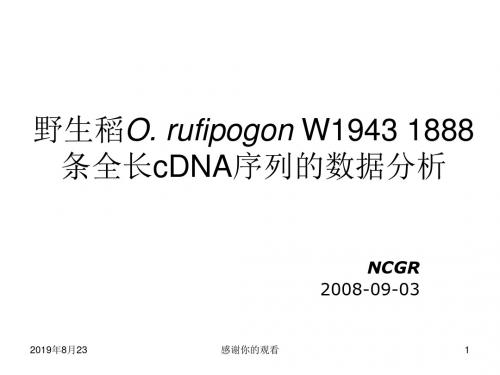
2个exon合并成单exon
2019年8月23
感谢你的观看
8
41 putative tissue-specific genes10/rice/
四、组织特异性高表达基因
name
len
orw1943s101k15 619bp
orw1943c102c24 833bp
-
CU406778
CU406596 Contig001277 AK242711
-
CU861677
CT842008 Contig008507 CT856206
--
CT841912
2019年8月23
感谢你的观看
93-11 contigs
Contig003011 Contig000750 -
ESTs or mRNA hits CT859459 AK099287 CT856885
99
CU861795 475
99
CU406355 837
100
CU406396 520
Chr location 05 09
12
02
Identity(%) Antisense protein
99
CA764081 DNA-directed RNA polymerase 3
79
CT858901 -
97
AK107125 AP2 domain, putative
2
1345
01
2
1107
01
2
952
01
2
893
01
3
665
10
3 感谢你的观看
protein
-
dual-specificity phosphatase protein
野生稻DNA导入栽培品种获得变异后代的抗病性分析
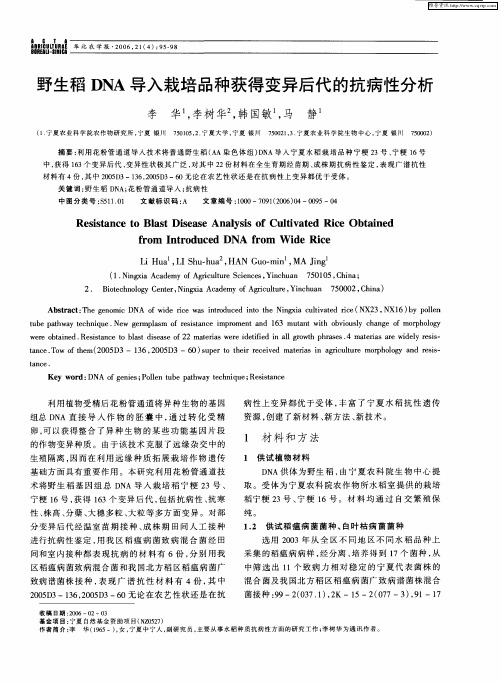
病性 上 变异都 优 于受 体 , 富 了宁 夏 水 稻 抗 性 遗 传 丰 资源 , 建 了新材 料 、 创 新方 法 、 技术 。 新
的作 物变 异种质 。由于 该技 术克 服 了远缘 杂交 中的 生殖 隔离 , 因而在 利 用 远 缘 种 质 拓 展 栽 培作 物 遗传
L u L h . u HA u . n , ig iH a , IS u h a , N G omi MA Jn ( . i x cdm f g cl r S i csY nh a 7 0 , hn ; 1 Nn i A a e yo A r u ue c ne, i u n 5 1 5 C ia ga i t e c 0 2 Bo cnlg et , igi A ae yo g cl r, icun 7 0 0 , h a . i eh o yC ne Nnx cd m f r ut eY nh a 50 2 C i ) t o r a Ai u n
基础方 面 具有重 要 作用 。本 研究 利用 花 粉管通 道 技 术将野 生 稻 基 因组 总 D A导入 栽 培 稻 宁粳 2 N 3号 、
1 材料 D A供 体为 野生 稻 , N 由宁夏 农 科 院生 物 中心 提
取 。受 体为 宁夏农 科 院农 作 物 所水 稻室 提供 的栽培 稻 宁粳 2 号 、 粳 1 3 宁 6号 。材 料 均 通 过 自交 繁 殖 保
李 华 李树 华 韩 国敏 马 静 , , ,
( . 夏农 业 科 学 院 农 作 物 研 究 所 , 1宁 宁夏 银 川 700 ,. 5152 宁夏 大 学 , 夏 银 川 宁 702 , 宁夏 农 业 科 学 院 生物 中 心 , 夏 银 川 50 13. 宁 700 ) 502
海南普通野生稻(Oryza rufipogon Griff.)Adh2基因多态性分析
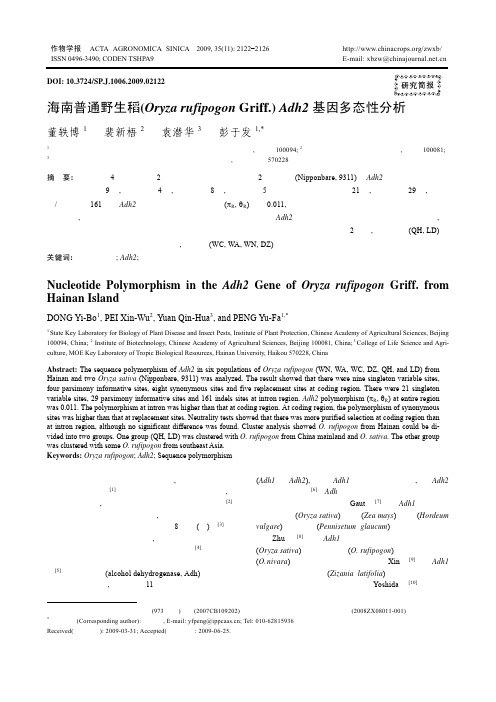
作物学报 ACTA AGRONOMICA SINICA 2009, 35(11): 2122−2126/zwxb/ISSN 0496-3490; CODEN TSHPA9E-mail: xbzw@本研究由国家重点基础研究发展计划(973计划)项目(2007CB109202)和转基因生物新品种培育重大专项课题(2008ZX08011-001)资助。
*通讯作者(Corresponding author): 彭于发, E-mail: yfpeng@; Tel: 010-********Received(收稿日期): 2009-03-31; Accepted(接受日期): 2009-06-25.DOI: 10.3724/SP.J.1006.2009.02122海南普通野生稻(Oryza rufipogon Griff.) Adh2基因多态性分析董轶博1 裴新梧2 袁潜华3 彭于发1,*1中国农业科学院植物保护研究所植物病虫害生物学国家重点实验室, 北京 100094; 2中国农业科学院生物技术研究所, 北京 100081; 3海南大学生命科学与农学院热带生物资源教育部重点实验室, 海南海口 570228摘 要: 海南岛的4个保护区和2个非保护区内普通野生稻与2种栽培稻(Nipponbare, 9311)的Adh2基因序列在编码区共有单现突变 9个, 信息位点4个, 同义突变8个, 替代突变5个。
内含子内有单现突变21个, 信息位点29个, 插入/缺失位点161个。
Adh2基因在整个区域的多态性(πR , θR )均为0.011, 内含子区域的多态性明显高于编码区域。
在编码区域, 同义位点多态性明显高于替代位点。
中性测试表明虽然Adh2各区域的净化选择在统计上不具有显著性, 但编码区的净化选择作用明显大于内含子区域。
聚类分析表明海南普通野生稻可以划分为2大类, 其中一类(QH, LD)与中国大陆普通野生稻和栽培稻更接近, 另一类(WC, WA, WN, DZ)则更接近东南亚普通野生稻。
东乡普通野生稻(OryzarufipogonGriff)原位保存群体的遗传分化和保护策略研究
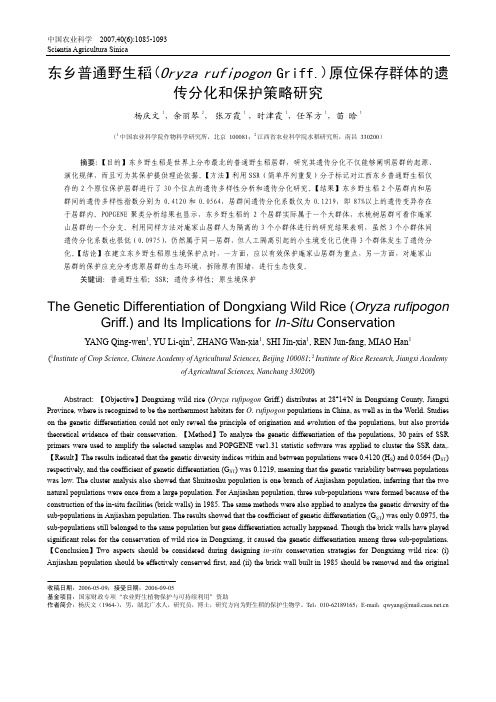
中国农业科学 2007,40(6):1085-1093Scientia Agricultura Sinica东乡普通野生稻(Oryza rufipogon Griff.)原位保存群体的遗传分化和保护策略研究杨庆文1,余丽琴2,张万霞1 ,时津霞1,任军方1,苗 晗1(1中国农业科学院作物科学研究所,北京 100081;2江西省农业科学院水稻研究所,南昌 330200)摘要:【目的】东乡野生稻是世界上分布最北的普通野生稻居群,研究其遗传分化不仅能够阐明居群的起源、演化规律,而且可为其保护提供理论依据。
【方法】利用SSR(简单序列重复)分子标记对江西东乡普通野生稻仅存的2个原位保护居群进行了30个位点的遗传多样性分析和遗传分化研究。
【结果】东乡野生稻2个居群内和居群间的遗传多样性指数分别为0.4120和0.0564,居群间遗传分化系数仅为0.1219,即87%以上的遗传变异存在于居群内。
POPGENE聚类分析结果也显示,东乡野生稻的2个居群实际属于一个大群体,水桃树居群可看作庵家山居群的一个分支。
利用同样方法对庵家山居群人为隔离的3个小群体进行的研究结果表明,虽然3个小群体间遗传分化系数也很低(0.0975),仍然属于同一居群,但人工隔离引起的小生境变化已使得3个群体发生了遗传分化。
【结论】在建立东乡野生稻原生境保护点时,一方面,应以有效保护庵家山居群为重点,另一方面,对庵家山居群的保护应充分考虑原居群的生态环境,拆除原有围墙,进行生态恢复。
关键词:普通野生稻;SSR;遗传多样性;原生境保护The Genetic Differentiation of Dongxiang Wild Rice (Oryza rufipogon Griff.) and Its Implications for In-Situ Conservation YANG Qing-wen1, YU Li-qin2, ZHANG Wan-xia1, SHI Jin-xia1, REN Jun-fang, MIAO Han1(1Institute of Crop Science, Chinese Academy of Agricultural Sciences, Beijing 100081; 2 Institute of Rice Research, Jiangxi Academyof Agricultural Sciences, Nanchang 330200)Abstract: 【Objective】Dongxiang wild rice (Oryza rufipogon Griff.) distributes at 28°14′N in Dongxiang County, Jiangxi Province, where is recognized to be the northernmost habitats for O. rufipogon populations in China, as well as in the World. Studies on the genetic differentiation could not only reveal the principle of origination and evolution of the populations, but also provide theoretical evidence of their conservation. 【Method】To analyze the genetic differentiation of the populations, 30 pairs of SSR primers were used to amplify the selected samples and POPGENE ver1.31 statistic software was applied to cluster the SSR data,. 【Result】The results indicated that the genetic diversity indices within and between populations were 0.4120 (H S) and 0.0564 (D ST) respectively, and the coefficient of genetic differentiation (G ST) was 0.1219, meaning that the genetic variability between populations was low. The cluster analysis also showed that Shuitaoshu population is one branch of Anjiashan population, inferring that the two natural populations were once from a large population. For Anjiashan population, three sub-populations were formed because of the construction of the in-situ facilities (brick walls) in 1985. The same methods were also applied to analyze the genetic diversity of the sub-populations in Anjiashan population. The results showed that the coefficient of genetic differentiation (G ST) was only 0.0975, the sub-populations still belonged to the same population but gene differentiation actually happened. Though the brick walls have played significant roles for the conservation of wild rice in Dongxiang, it caused the genetic differentiation among three sub-populations. 【Conclusion】Two aspects should be considered during designing in-situ conservation strategies for Dongxiang wild rice: (i) Anjiashan population should be effectively conserved first, and (ii) the brick wall built in 1985 should be removed and the original收稿日期:2006-05-09;接受日期:2006-09-05基金项目:国家财政专项“农业野生植物保护与可持续利用”资助作者简介:杨庆文(1964-),男,湖北广水人,研究员,博士,研究方向为野生稻的保护生物学。
稻瘟病菌发育cDNA文库构建与表达序列标签分析pdf
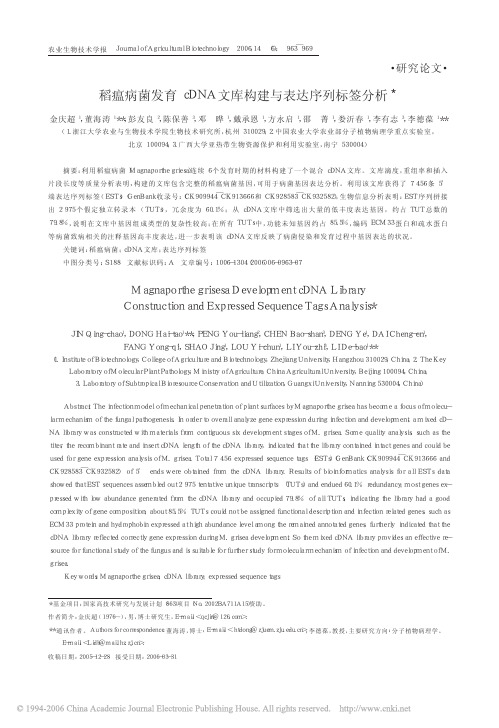
农业生物技术学报JournalofAgriculturalBiotechnology2006,14(6):963 ̄969・研究论文・稻瘟病菌发育cDNA文库构建与表达序列标签分析*金庆超1,董海涛1**,彭友良2,陈保善3,邓晔1,戴承恩1,方永启1,邵菁1,娄沂春1,李有志3,李德葆1**(1.浙江大学农业与生物技术学院生物技术研究所,杭州310029;2.中国农业大学农业部分子植物病理学重点实验室,北京100094;3.广西大学亚热带生物资源保护和利用实验室,南宁530004)摘要:利用稻瘟病菌(Magnaporthegriesa)连续6个发育时期的材料构建了一个混合cDNA文库。
文库滴度,重组率和插入片段长度等质量分析表明,构建的文库包含完整的稻瘟病菌基因,可用于病菌基因表达分析。
利用该文库获得了7456条5′端表达序列标签(ESTs)(GenBank收录号:(CK909944 ̄CK913666和CK928583 ̄CK932582),生物信息分析表明:EST序列拼接出2975个假定独立转录本(TUTs),冗余度为60.1%;从cDNA文库中筛选出大量的低丰度表达基因,约占TUT总数的79.8%,说明在文库中基因组成类型的复杂性较高;在所有TUTs中,功能未知基因约占85.5%,编码ECM33蛋白和疏水蛋白等病菌致病相关的注释基因高丰度表达,进一步表明该cDNA文库反映了病菌侵染和发育过程中基因表达的状况。
关键词:稻瘟病菌;cDNA文库;表达序列标签中图分类号:S188文献标识码:A文章编号:1006-1304(2006)06-0963-07MagnaporthegrisesaDevelopmentcDNALibraryConstructionandExpressedSequenceTagsAnalysis*JINQing-chao1,DONGHai-tao1**,PENGYou-liang2,CHENBao-shan3,DENGYe1,DAICheng-en1,FANGYong-qi1,SHAOJing1,LOUYi-chun1,LIYou-zhi3,LIDe-bao1**(1.InstituteofBiotechnology,CollegeofAgricultureandBiotechnology,ZhejiangUniversity,Hangzhou310029,China;2.TheKeyLaboratoryofMolecularPlantPathology,MinistryofAgriculture,ChinaAgriculturalUniversity,Beijing100094,China;3.LaboratoryofSubtropicalBioresourceConservationandUtilization,GuangxiUniversity,Nanning530004,China)Abstract:TheinfectionmodelofmechanicalpenetrationofplantsurfacesbyMagnaporthegriseahasbecomeafocusofmolecu-larmechanismofthefungalpathogenesis.Inordertooverallanalyzegeneexpressionduringinfectionanddevelopment,amixedcD-NAlibrarywasconstructedwithmaterialsfromcontiguoussixdevelopmentstagesofM.grisea.Somequalityanalysis,suchasthetiter,therecombinantrateandinsertcDNAlengthofthecDNAlibrary,indicatedthatthelibrarycontainedintactgenesandcouldbeusedforgeneexpressionanalysisofM.grisea.Total7456expressedsequencetags(ESTs)(GenBank(CK909944 ̄CK913666andCK928583 ̄CK932582)of5′endswereobtainedfromthecDNAlibrary.ResultsofbioinformaticsanalysisforallESTsdatashowedthatESTsequencesassembledout2975tentativeuniquetranscripts(TUTs)andendued60.1%redundancy;mostgenesex-pressedwithlowabundancegeneratedfromthecDNAlibraryandoccupied79.8%ofallTUTs,indicatingthelibraryhadagoodcomplexityofgenecomposition;about85.5%TUTscouldnotbeassignedfunctionaldescriptionandinfectionrelatedgenes,suchasECM33proteinandhydrophobinexpressedathighabundancelevelamongtheremainedannotatedgenes,furtherlyindicatedthatthecDNAlibraryreflectedcorrectlygeneexpressionduringM.griseadevelopment.SothemixedcDNAlibraryprovidesaneffectivere-sourceforfunctionalstudyofthefungusandissuitableforfurtherstudyformolecularmechanismofinfectionanddevelopmentofM.grisea.Keywords:Magnaporthegrisea;cDNAlibrary;expressedsequencetags*基金项目:国家高技术研究与发展计划(863)项目(No.2002BA711A15)资助。
普通野生稻叶绿体dna的多态性
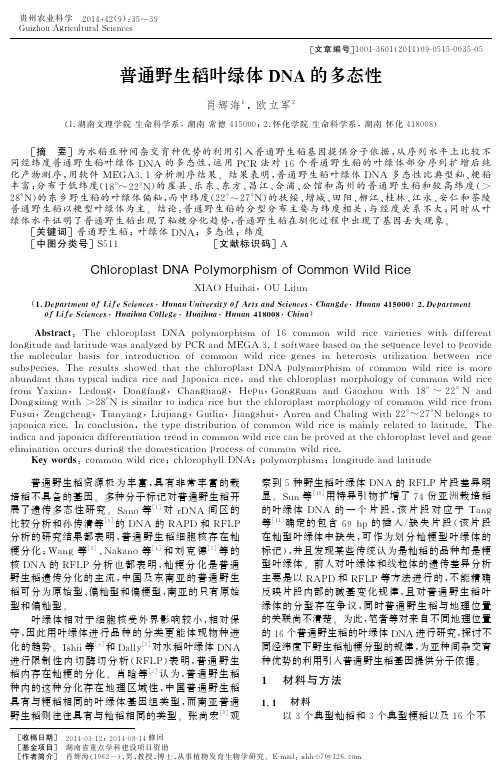
[收稿日期] 2014 03 12;2014 08 14修回 [基金项目] 湖南省重点学科建设项目资助 [作者简介] 肖辉海(1962-),男,教授,博士,从事植物发育生物学研究。
E mail:xhh 07@126.com[文章编号]1001 3601(2014)09 0515 0035 05普通野生稻叶绿体DNA的多态性肖辉海1,欧立军2(1.湖南文理学院生命科学系,湖南常德415000;2.怀化学院生命科学系,湖南怀化418008) [摘 要]为水稻亚种间杂交育种优势的利用引入普通野生稻基因提供分子依据,从序列水平上比较不同经纬度普通野生稻叶绿体DNA的多态性,运用PCR法对16个普通野生稻的叶绿体部分序列扩增后纯化产物测序,用软件MEGA3.1分析测序结果。
结果表明,普通野生稻叶绿体DNA多态性比典型籼、粳稻丰富;分布于低纬度(18°~22°N)的崖县、乐东、东方、昌江、合浦、公馆和高州的普通野生稻和较高纬度(>28°N)的东乡野生稻的叶绿体偏籼,而中纬度(22°~27°N)的扶绥、增城、田阳、柳江、桂林、江永、安仁和茶陵普通野生稻以粳型叶绿体为主。
结论:普通野生稻的分型分布主要与纬度相关,与经度关系不大;同时从叶绿体水平证明了普通野生稻出现了籼粳分化趋势,普通野生稻在驯化过程中出现了基因丢失现象。
[关键词]普通野生稻;叶绿体DNA;多态性;纬度[中图分类号]S511[文献标识码]AChloroplastDNAPolymorphismofCommonWildRiceXIAOHuihai,OULijun(1.DepartmentofLifeSciences,HunanUniversityofArtsandSciences,Changde,Hunan415000;2.DepartmentofLifeSciences,HuaihuaCollege,Huaihua,Hunan418008,China) Abstract:ThechloroplastDNApolymorphismof16commonwildricevarietieswithdifferentlongitudeandlatitudewasanalyzedbyPCRandMEGA3.1softwarebasedonthesequenceleveltoprovidethemolecularbasisforintroductionofcommonwildricegenesinheterosisutilizationbetweenricesubspecies.TheresultsshowedthatthechloroplastDNApolymorphismofcommonwildriceismoreabundantthantypicalindicariceandJaponicarice,andthechloroplastmorphologyofcommonwildricefromYaxian,Ledong,Dongfang,Changjiang,Hepu,GongguanandGaozhouwith18°~22°NandDongxiangwith>28°NissimilartoindicaricebutthechloroplastmorphologyofcommonwildricefromFusui,Zengcheng,Tianyang,Liujiang,Guilin,Jiangshui,AnrenandChalingwith22°~27°Nbelongstojaponicarice.Inconclusion,thetypedistributionofcommonwildriceismainlyrelatedtolatitude.Theindicaandjaponicadifferentiationtrendincommonwildricecanbeprovedatthechloroplastlevelandgeneeliminationoccursduringthedomesticationprocessofcommonwildrice.Keywords:commonwildrice;chlorophyllDNA;polymorphism;longitudeandlatitude 普通野生稻资源极为丰富,具有非常丰富的栽培稻不具备的基因。
水稻抗病基因Lrr19类似物序列分析研究
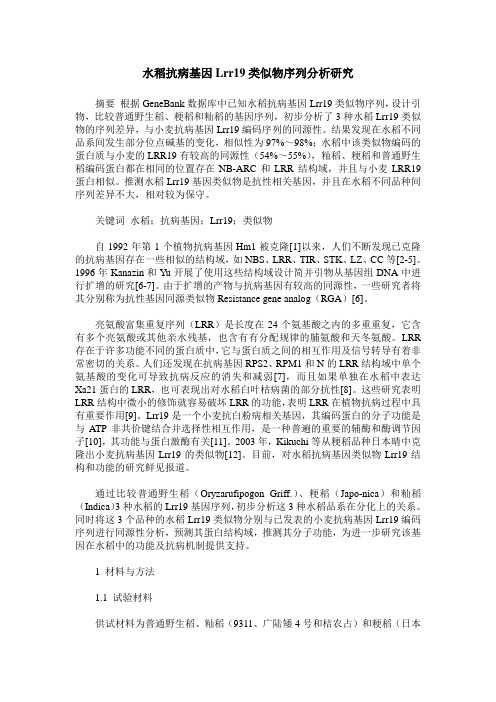
水稻抗病基因Lrr19类似物序列分析研究摘要根据GeneBank数据库中已知水稻抗病基因Lrr19类似物序列,设计引物,比较普通野生稻、粳稻和籼稻的基因序列,初步分析了3种水稻Lrr19类似物的序列差异,与小麦抗病基因Lrr19编码序列的同源性。
结果发现在水稻不同品系间发生部分位点碱基的变化,相似性为97%~98%;水稻中该类似物编码的蛋白质与小麦的LRR19有较高的同源性(54%~55%),籼稻、粳稻和普通野生稻编码蛋白都在相同的位置存在NB-ARC和LRR结构域,并且与小麦LRR19蛋白相似。
推测水稻Lrr19基因类似物是抗性相关基因,并且在水稻不同品种间序列差异不大,相对较为保守。
关键词水稻;抗病基因;Lrr19;类似物自1992年第1个植物抗病基因Hm1被克隆[1]以来,人们不断发现已克隆的抗病基因存在一些相似的结构域,如NBS、LRR、TIR、STK、LZ、CC等[2-5]。
1996年Kanazin和Yu开展了使用这些结构域设计简并引物从基因组DNA中进行扩增的研究[6-7]。
由于扩增的产物与抗病基因有较高的同源性,一些研究者将其分别称为抗性基因同源类似物Resistance gene analog(RGA)[6]。
亮氨酸富集重复序列(LRR)是长度在24个氨基酸之内的多重重复,它含有多个亮氨酸或其他亲水残基,也含有有分配规律的脯氨酸和天冬氨酸。
LRR 存在于许多功能不同的蛋白质中,它与蛋白质之间的相互作用及信号转导有着非常密切的关系。
人们还发现在抗病基因RPS2、RPM1和N的LRR结构域中单个氨基酸的变化可导致抗病反应的消失和减弱[7],而且如果单独在水稻中表达Xa21蛋白的LRR,也可表现出对水稻白叶枯病菌的部分抗性[8]。
这些研究表明LRR结构中微小的修饰就容易破坏LRR的功能,表明LRR在植物抗病过程中具有重要作用[9]。
Lrr19是一个小麦抗白粉病相关基因,其编码蛋白的分子功能是与ATP非共价键结合并选择性相互作用,是一种普遍的重要的辅酶和酶调节因子[10],其功能与蛋白激酶有关[11]。
云南野生稻抗稻瘟病Pi
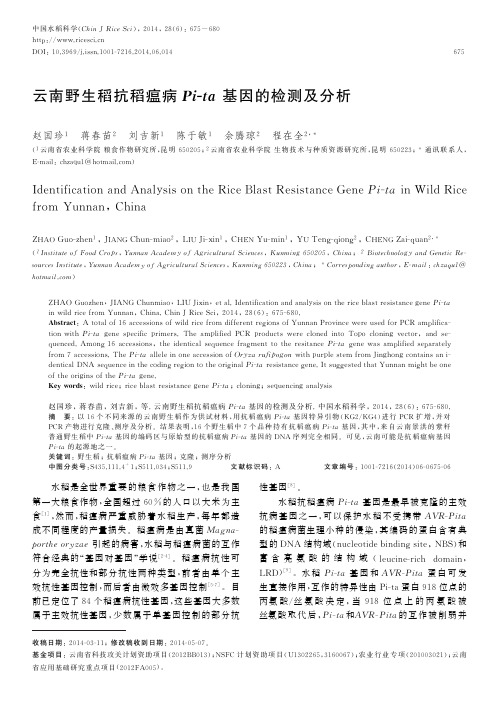
云南野生稻抗稻瘟病P i Gt a 基因的检测及分析赵国珍1㊀蒋春苗2㊀刘吉新1㊀陈于敏1㊀余腾琼2㊀程在全2,∗(1云南省农业科学院粮食作物研究所,昆明650205;2云南省农业科学院生物技术与种质资源研究所,昆明650223;∗通讯联系人,E Gm a i l :c h z a qu 1@h o t m a i l .c o m )I d e n t i f i c a t i o n a n dA n a l ys i s o n t h eR i c eB l a s tR e s i s t a n c eG e n e P i Gt a i nW i l dR i c e f r o m Y u n n a n ,C h i n aZ H A O G u o Gz h e n 1,J I A N G C h u n Gm i a o 2,L I U J i Gx i n 1,C H E N Y u Gm i n 1,Y U T e n g Gq i o n g 2,C H E N G Z a i Gqu a n 2,∗(1I n s t i t u t e o f F o o dC r o p s ,Y u n n a nA c a d e m y o f A g r i c u l t u r a lS c i e n c e s ,K u n m i n g 650205,C h i n a ;2B i o t e c h n o l o g y an dG e n e t i cR e Gs o u r c e s I n s t i t u t e ,Y u n n a nA c a d e m y o f A g r i c u l t u r a l S c i e n c e s ,K u n m i n g 650223,C h i n a ;∗C o r r e s p o n d i n g a u t h o r ,E Gm a i l :c h z a q u 1@h o t m a i l .c o m )Z HA O G u o z h e n ,J I A N GC h u n m i a o ,L I UJ i x i n ,e t a l .I d e n t i f i c a t i o n a n d a n a l ys i s o n t h e r i c e b l a s t r e s i s t a n c e g e n e P i Gt a i nw i l d r i c e f r o m Y u n n a n ,C h i n a .C h i n JR i c eS c i ,2014,28(6):675G680.A b s t r a c t :At o t a l o f 16a c c e s s i o n s o fw i l d r i c e f r o md i f f e r e n t r e g i o n s o fY u n n a nP r o v i n c ew e r e u s e d f o rP C Ra m pl i f i c a Gt i o nw i t h P i Gt a g e n es p e c i f i c p r i m e r s .T h ea m p l i f i e dP C R p r o d u c t s w e r ec l o n e di n t o T o p oc l o n i n g ve c t o r ,a n ds e Gq u e n c e d .A m o n g 16a c c e s s i o n s ,t h e i d e n t i c a l s e q u e n c ef r ag m e n t t oth er e si t a n c e P i Gt a g e n ew a sa m p l i f i e ds e p a r a t e l yf r o m7a c c e s s i o n s .T h e P i Gt a a l l e l e i no n e a c c e s s i o no f O r y z a r u f i p og o n w i th p u r p l e s t e mf r o mJi n g h o n g c o n t a i n s a n i Gd e n t i c a lD N As e q u e n c e i n t h e c o d i n g r e g i o n t o t h e o r i g i n a l P i Gt a r e s i s t a n c e g e n e .I t s u g g e s t e d t h a tY u n n a nm i g h t b e o n e o f t h e o r i gi n s o f t h e P i Gt a g e n e .K e y w o r d s :w i l d r i c e ;r i c eb l a s t r e s i s t a n c e g e n e P i Gt a ;c l o n i n g ;s e q u e n c i n g a n a l y s i s 赵国珍,蒋春苗,刘吉新,等.云南野生稻抗稻瘟病P i Gt a 基因的检测及分析.中国水稻科学,2014,28(6):675G680.摘㊀要:以16个不同来源的云南野生稻作为供试材料,用抗稻瘟病P i Gt a 基因特异引物(K G 2/K G 4)进行P C R 扩增,并对P C R 产物进行克隆㊁测序及分析.结果表明,16个野生稻中7个品种持有抗稻瘟病P i Gt a 基因,其中,来自云南景洪的紫秆普通野生稻中P i Gt a 基因的编码区与原始型的抗稻瘟病P i Gt a 基因的D N A 序列完全相同.可见,云南可能是抗稻瘟病基因P i Gt a 的起源地之一.关键词:野生稻;抗稻瘟病P i Gt a 基因;克隆;测序分析中图分类号:S 435.111.4+1;S 511.034;S 511.9㊀㊀㊀㊀㊀文献标识码:A㊀㊀㊀文章编号:1001G7216(2014)06G0675G06㊀㊀水稻是全世界重要的粮食作物之一,也是我国第一大粮食作物,全国超过60%的人口以大米为主食[1],然而,稻瘟病严重威胁着水稻生产,每年都造成不同程度的产量损失.稻瘟病是由真菌M a g n a Gp o r t h e o r yz a e 引起的病害,水稻与稻瘟病菌的互作符合经典的 基因对基因 学说[2G4].稻瘟病抗性可分为完全抗性和部分抗性两种类型,前者由单个主效抗性基因控制,而后者由微效多基因控制[5G7].目前已定位了84个稻瘟病抗性基因,这些基因大多数属于主效抗性基因,少数属于单基因控制的部分抗性基因[8].水稻抗稻瘟病P i Gt a 基因是最早被克隆的主效抗病基因之一,可以保护水稻不受携带A V R GP i t a 的稻瘟病菌生理小种的侵染,其编码的蛋白含有典型的D N A 结构域(n u c l e o t i d e b i n d i n g si t e ,N B S )和富含亮氨酸的结构域(l e u c i n e Gr i c h d o m a i n ,L R D )[9].水稻P i Gt a 基因和A V R GP i t a 蛋白可发生直接作用,互作的特异性由P i Gt a 蛋白918位点的丙氨酸/丝氨酸决定,当918位点上的丙氨酸被丝氨酸取代后,P i Gt a 和A V R GP i t a 的互作被削弱并收稿日期:2014G03G11;修改稿收到日期:2014G05G07.基金项目:云南省科技攻关计划资助项目(2012B B 013);N S F C 计划资助项目(U 1302265,3160067);农业行业专项(201003021);云南省应用基础研究重点项目(2012F A 005).576中国水稻科学(C h i nJR i c eS c i ),2014,28(6):675-680h t t p ://w w w.r i c e s c i .c n D O I :10.3969/j.i s s n .1001G7216.2014.06.014导致水稻感病[2,9].P iGt a基因具有保守的序列信息和功能特性,而与其相应的A V RGP i t a位点序列却变异较多,进化速度快[10G11].因此,系统地分析水稻P iGt a基因位点和蛋白序列的变异,有助于了解P iGt a基因的变异与水稻抗病性之间的关系[12].由于不同水稻品种间的P iGt a基因存在大量的遗传多态性,通过分析P iGt a基因在核苷酸水平上的多态性,可明确其蛋白918位点丙氨酸的功能,了解稻瘟病P iGt a基因的起源与进化.野生稻作为栽培稻的祖先,长期处于野生状态,经受各种灾害和恶劣环境的选择,具有各种抗病虫性和耐不良环境的优良特性,如抗稻瘟病㊁高抗白叶枯病等.云南是亚洲栽培稻的起源地之一,具有我国三种野生稻.目前,针对P iGt a基因的研究大多集中在其结构㊁功能及其调控机理等方面[9,13G16],而关于云南三种野生稻中P iGt a基因序列㊁蛋白位点分析及起源进步等目前尚未见报道,因此本研究以云南不同地方的6个药用野生稻㊁4个普通野生稻和6个疣粒野生稻居群为研究材料,设计引物扩增P iGt a基因的序列,通过测序分析云南野生稻中P iGt a基因在核苷酸水平上的多态性,并与原始型的P iGt a基因进行序列比对,旨在为研究抗稻瘟病P iGt a基因的起源提供依据,为选育抗稻瘟病栽培品种提供材料.1㊀材料与方法1.1㊀水稻材料以16个来源于云南省不同地方的野生稻作为本研究的供试材料,材料名称及来源详见表1.1.2㊀抗稻瘟病基因P iGt a的扩增云南野生稻幼苗在温室内生长至3~4叶,取新鲜叶片参照C T A B法提取基因组D N A[17],以抗稻瘟病P iGt a基因K G2和K G4作为特异引物[16](表2),对云南野生稻抗稻瘟病基因P iGt a进行扩增. P C R体系总体积为20μL,其中D N A1μL,上下游引物(K G2和K G4)各1μL,T a K a R aL A T a q D N A聚合酶(由美国Q i a g e n公司生产)10μL, M g C l21.5μL,蒸馏水5.5μL.在P e l t i e rT h e r m a l C y e l e rP T CG20仪上进行(M JR e s e a r c h,W a l t h a m, MA)P C R,反应程序如下:94ħ下预变性4m i n;94ħ下30s,55ħ下30s,72ħ下2m i n,30个循环;表1㊀供试材料基本情况T a b l e1.I n f o r m a t i o n o f t e s tm a t e r i a l s.序号C o d e 材料名称N a m e来源O r i g i n1药用野生稻(耿马)O.o f f i c i n a l i s(G e n g m a)云南省耿马县G e n g m aC o u n t y,Y u n n a n,C h i n a 2药用野生稻(勐海)O.o f f i c i n a l i s(M e n g h a i)云南省勐海县M e n g h a i C o u n t y,Y u n n a n,C h i n a 3药用野生稻(勐海)O.o f f i c i n a l i s(M e n g h a i)云南省勐海县M e n g h a i C o u n t y,Y u n n a n,C h i n a 4药用野生稻(勐遮)O.o f f i c i n a l i s(M e n g z h e)云南省勐遮县M e n g z h eC o u n t y,Y u n n a n,C h i n a 5药用野生稻1O.o f f i c i n a l i s16药用野生稻2O.o f f i c i n a l i s27普通野生稻(景洪)1O.r u f i p o g o n(J i n g h o n g)1云南省景洪县J i n g h o n g C o u n t y,Y u n n a n,C h i n a 8普通野生稻(景洪)2O.r u f i p o g o n(J i n g h o n g)2云南省景洪县J i n g h o n g C o u n t y,Y u n n a n,C h i n a 9普通野生稻(景洪,绿秆)O.r u f i p o g o n(J i n g h o n g,g r e e n s t e m)云南省景洪县J i n g h o n g C o u n t y,Y u n n a n,C h i n a 10普通野生稻(景洪,紫秆)O.r u f i p o g o n(J i n g h o n g,p u r p l e s t e m)云南省景洪县J i n g h o n g C o u n t y,Y u n n a n,C h i n a 11疣粒野生稻(澜沧江)O.m e y e r i a n a(L a n c a n g j i a n g)云南省澜沧江L a n c a n g j i a n g C o u n t y,Y u n n a n,C h i n a 12疣粒野生稻(郑康赤水关)O.m e y e r i a n a(C h i s h u i g u a n,Z h e n g k a n g)云南省澜沧县L a n c a n g C o u n t y,Y u n n a n,C h i n a 13疣粒野生稻(澜沧)O.m e y e r i a n a(L a n c a n g)云南省澜沧县L a n c a n g C o u n t y,Y u n n a n,C h i n a 14疣粒野生稻(景洪)O.m e y e r i a n a(J i n g h o n g)云南省景洪县J i n g h o n g C o u n t y,Y u n n a n,C h i n a 15疣粒野生稻(普洱)O.m e y e r i a n a(P u e r)云南省普洱市P u e rC i t y,Y u n n a n,C h i n a16疣粒野生稻(孟定)O.m e y e r i a n a(M e n g d i n g)云南省孟定县M e n g d i n g C o u n t y,Y u n n a n,C h i n a表2㊀P iGt a基因引物序列T a b l e2.P r i m e r s e q u e n c e f o r P iGt a g e n e.引物名称P r i m e r n a m e序列(5ᶄG3ᶄ)S e q u e n c e(5ᶄG3ᶄ)退火温度A n n e a l i n g t e m p e r a t u r e/ħK G2T G CC A A A G CT A CA G G T T CA A T T55.2K G4G A CT A G G A AC C AC A CC T TC T53.6676中国水稻科学(C h i nJR i c eS c i)㊀第28卷第6期(2014年11月)表3㊀用于测序的P iGt a基因引物序列T a b l e3.L i s t o f o l i gGn u c l e o t i d e s u s e d f o r s e q u e n c e a n a l y s i s.引物P r i m e r序列(5ᶄG3ᶄ)S e q u e n c e(5ᶄG3ᶄ)退火温度A n n e a l i n g t e m p e r a t u r e/ħT3A T T A A CC C TC A CT A A A G42.1T7T A A T A CG A CT C AC T A T A G G G47.5M13F G T A A A AC G AC G GC C A G T52.6M13R C A G G A A A C A G C T A T G A C C45.0F8G5T C CT C A G A G G C G A T CT C CG58.5Y L71A G CA G T A A G T T G T A A T T T A T50.2Y L80C A G G A T G A CC T T G A CA C TC T60.4Y L83G G T A C CC G A G A A A A T A T A G G58.4Y L87C T AC C A A C A A G T T C A T C A A A54.3Y L90G T A T G A A A CA T G T A CT T TC A52.2Y L68G G CC G AC G GC G A G C CG A A G C72.7Y L69G G A T G T T T G G G A G G T T G A T C60.4Y L82A G A G A CT T G G A T G A A G A T T T54.3Y L100C C CA A T G C CG A G T G T G C A A A G G66.4Y L102T C A G G T T G A A G A T G CA T A G C58.4Y L153C A A C A A T T T A A TC A T A C AC G44.8Y L154A T G A C AC C CT G CG A T G C A A57.4Y L155A G CA G G T T A T A A G C T A G GC C54.1XW23G T T A G T A G A A T G A G G T G G G T51.1X Y6G C T G C TC T TC T CT C TC T TC C T56.0XW13A A AC T A T C CG G AC G CA T T T G53.2XW14T G CC A A A G CT A CA G G T T CA A T T55.2Y L75C A AC A G A A A T T G A A CC T G T A54.3Y L76G G A A T GC A GC A A T G G A A TC A58.4Y L77T T T G A T G A AC T T G T T G G T A G54.3Y L85A C A G C A G T T G C TC T T G C A T C60.4Y L86C A T A C AC T T G A CT T G T C CG A58.472ħ下延伸5m i n.反应结束后取6μLP C R产物并加入2μLL o a d i n g D y e,在0.1%琼脂糖凝胶(S BGG R染色)中于85V电压下电泳1h,用凝胶成像仪扫描拍照.1.3㊀P iGt a基因的克隆及测序P C R产物的克隆采用T O P O4P C RC l o n i n g试剂盒进行,该试剂盒购自美国Q i a g e n公司.操作步骤如下:在P C R产物中加入1μL载体,室温下静置30m i n后,加入20μL感受态细胞,迅速进行电击转化.电击后,冰上静置5m i n,加入500μLS O C 培养液,置于带振荡器的恒温箱中(37ħ)培养1h,然后取100μL培养液于含有50m g/L卡那霉素的L B固体培养基中,用弹珠混匀,室温下静置3~5m i n,将培养皿倒置在37ħ恒温箱中过夜培养.第2天观察培养情况,每一个培养皿中分别挑出5个白色克隆,转到S O C培养液中,置于带振荡器的恒温箱(37ħ)中继续过夜培养,第3天收集培养液提取质粒D N A.质粒D N A的提取采用Q i a g e n K i t 试剂盒按规程进行(美国Q i a g e n公司).使用27个抗稻瘟病基因P iGt a特异引物进行测序(表3), D N A测序由美国密西西比州斯通维尔U S D AGA R S M S A基因组学实验室完成.1.4㊀数据分析采用V e c t o rN T IV.10软件进行序列拼接,野生稻的抗稻瘟病P iGt a基因与原始抗稻瘟病基因P iGt a的序列比对及相似性分析用M E G A4.0软件进行.2㊀结果与分析2.1㊀P iGt a基因的扩增结果K G2/K G4引物能对供试野生稻中的7个品种扩增出特异性条带,片段大小为4275b p,与预期结果一致,说明供试的7个野生稻品种持有抗稻瘟病基因P iGt a(图1).这7个品种分别是药用野生稻776赵国珍等:云南野生稻抗稻瘟病P iGt a基因的检测及分析1-药用野生稻(耿马);2-药用野生稻(勐海);3-药用野生稻(勐海);4-药用野生稻(勐遮);5-药用野生稻1;6-药用野生稻2;7-普通野生稻1(景洪);8-普通野生稻2(景洪);9-普通野生稻(景洪,绿秆);10-普通野生稻(景洪,紫秆);11-疣粒野生稻(澜沧江);12-疣粒野生稻(郑康赤水关);13,疣粒野生稻(澜沧);14,疣粒野生稻(景洪);15,疣粒野生稻(普洱);16,疣粒野生稻(孟定).1,O.o f f i c i n a l i s(G e n g m a);2,O.o f f i c i n a l i s(M e n g h a i);3,O.o f f i c i n a l i s(M e n g h a i);4,O.o f f i c i n a l i s(M e n g z h e);5,O.o f f i c i n a l i s1;6,O.o f f i c i n a l i s2;7,O.r u f i p o g o n1(J i n g h o n g);8,O.r u f i p o g o n2(J i n g h o n g);9,O.r u f i p o g o n(J i n g h o n g,g r e e n s t e m);10,O.r u f iGp o g o n(J i n g h o n g,p u r p l e s t e m);11,O.m e y e r i a n a(L a n c a n g j i a n g);12,O.m e y e r i a n a(C h i s h u i g u a n,Z h e n g k a n g);13,O.m e y e r i a n a(L a nGc a n g);14,O.m e y e r i a n a(J i n g h o n g);15,O.m e y e r i a n a(P u e r);16,O.m e y e r i a n a(M e n g d i n g).图1㊀云南野生稻P iGt a基因的扩增结果F i g.1.A m p l i f i c a t i o n r e s u l t s o f P iGt a g e n e i nY u n n a nw i l d r i c e.1㊁药用野生稻2㊁普通野生稻1(景洪)㊁普通野生稻2(景洪)㊁普通野生稻(景洪,绿秆)㊁普通野生稻(景洪,紫秆)和疣粒野生稻(澜沧江).2.2㊀抗稻瘟病基因P iGt a序列比对分析对P iGt a基因的2个外显子和一个内含子共4275b p的D N A序列进行测序比对分析,发现7个供试野生稻品种P iGt a位点的核苷酸序列间均存在差异.P iGt a位点的氨基酸情况及相似性分析结果表明(表4和图2),来自景洪的普通野生稻(紫秆) P iGt a位点的核苷酸序列和氨基酸与原始P iGt a序列完全相同,说明云南可能是抗稻瘟病基因P iGt a 的起源地之一.其余6个野生稻中,P iGt a位点的核苷酸序列相似性最高的是药用野生稻1和药用野生稻2,其相似性达70%.来自澜沧江的疣粒野生稻与其他野生稻在P iGt a位点的核苷酸序列差异最大.3㊀讨论P iGt a基因是B r y a n等[9]通过作图的方法从日本栽培稻社糯(Y a s h i r oGm o c h i)中克隆获得,该基因位于水稻第12染色体着丝点附近,编码由928个氨基酸残基组成的富含亮氨酸重复序列的细胞质膜受体蛋白.对抗稻瘟病品种和感稻瘟病的P iGt a基因序列分析表明,抗病水稻品种的P iGt a基因与感病表4㊀野生稻品种中P iGt a基因氨基酸序列变化T a b l e4.A m i n o a c i d v a r i a t i o na m o n g a c c e s s i o n s o fw i l d r e l a t i v e s o f r i c e.材料M a t e r i a l氨基酸位次A m i n o a c i d p o s i t i o n6728118148158176365498660808810918919P iGt a[9]I A P G R H D H F P Q D A M 药用野生稻1O.o f f i c i n a l i s1S A L G S Q V H F L Q D S M 药用野生稻2O.o f f i c i n a l i s2S A P G S Q V H F P Q G S M 普通野生稻(景洪)S E P G R H D H F P Q D S M O.r u f i p o g o n(J i n g h o n g)普通野生稻(景洪)S E P G R H V H F P Q D S M O.r u f i p o g o n(J i n g h o n g)普通野生稻(景洪,绿秆)S A P S R H D H F P E D S M O.r u f i p o g o n(J i n g h o n g,g r e e n s t e m)普通野生稻(景洪,紫秆)I A P G R H D H F P Q D A M O.r u f i p o n g o n(J i n g h o n g,p u r p l e s t e m)疣粒野生稻(澜沧江)S E P G R H D Y L P Q D S I O.m e y e r i a n a(L a n c a n g j i a n g)876中国水稻科学(C h i nJR i c eS c i)㊀第28卷第6期(2014年11月)图2㊀P iGt a位点在7个野生稻中的聚类分析F i g.2.C l u s t e r a n a l y s i s o f t h e P iGt a a l l e l e a m o n g a c c e s s i o n s o fw i l d r e l a t i v e s o f r i c e.水稻品种的P iGt a基因产物之间仅有一个氨基酸残基的差异,即918位点上抗病P iGt a基因产物为丙氨酸,而感病p iGt a等位基因该位点为丝氨酸[2,18].本研究中,从16个云南野生稻中检测出7个品种携带P iGt a基因.通过序列比对,P iGt a位点的核苷酸序列相似性最高的是药用野生稻1和药用野生稻2,其相似性达70%,来自澜沧江的疣粒野生稻与其他野生稻间P iGt a位点的核苷酸序列差异最大.但是仅有来自景洪的紫秆普通野生稻中分离克隆的P iGt a基因918位点上为丙氨酸,并且该基因的核苷酸序列和氨基酸与原始型的抗稻瘟病基因P iGt a 的D N A序列完全相同;聚类分析表明,含P iGt a基因的云南野生稻遗传多样性丰富,可聚成6类,其中景洪的紫秆普通野生稻的P iGt a基因与原始型的P iGt a基因聚为一支,可能是由同一祖先进化而来,而景洪的紫秆普通野生稻有可能是最早含有P iGt a 抗性基因的野生稻资源.由此推测,云南可能是抗稻瘟病基因P iGt a的起源地之一.P iGt a基因仅存在一种序列控制稻瘟病,决定P iGt a基因识别特异性的关键是其蛋白序列918位点的丙氨酸/丝氨酸,丙氨酸可使P iGt a基因识别A V RGP i t a,进而使水稻获得抗性,如果该位点是丝氨酸则不具备该功能[9,19].7个云南野生稻品种克隆到的P iGt a基因,除景洪紫秆普通野生稻的918位点为丙氨酸,其余6个野生稻品种均为丝氨酸,因此这6个野生稻品种中的P iGt a基因不具备使其获得抗性的功能.本课题组前期对这6个野生稻品种进行稻瘟病抗性鉴定分析,发现这6个野生稻对稻瘟病均表现出不同程度的抗性.因此,本研究可以确定这6个云南野生稻品种对稻瘟病的抗性不是P iGt a基因所决定,但可以明确这6个云南野生稻品种含有P iGt a抗性基因外的其他已知的抗性基因或是尚未发现分离的抗稻瘟病新基因.这有待进一步的研究.抗稻瘟病品种的选育是防治稻瘟病最经济㊁有效的途径.抗稻瘟病基因P iGt a在我国很多稻区表现高水平的稻瘟病抗性,被广泛应用于我国的水稻育种和生产[20G23].本研究发现来源于云南景洪的紫秆普通野生稻持有抗稻瘟病P iGt a基因,由于普通野生稻与栽培稻同属A A基因组型,不存在严重的生殖隔离[24],因此可以利用杂交的手段将该野生稻中的抗稻瘟病基因P iGt a导入栽培稻,也可以通过转基因方法直接将获得的P iGt a基因导入不抗病的高产优质栽培稻品种中,以改良其稻瘟病抗性.另外6个云南野生稻品种的抗稻瘟病能力不是由P iGt a基因赋予,可能含有P iGt a抗性基因外的其他已知抗性基因或是尚未发现的抗稻瘟病新基因.参考文献:[1]㊀朱德峰,程式华,张玉屏,等.全球水稻生产现状与制约因素分析.中国农业科学,2010,43(3):474G479.[2]㊀J i aYL,M c A d a m s SA,B r y a nG T,e t a l.D i r e c t i n t e r a c t i o n o f r e s i s t a n c e g e n ea n da v i r u l e n c e g e n e p r o d u c t sc o n f e r sr i c eb l a s t r e s i s t a nc e.E M B OJ,2000,19(15):4004G4014.[3]㊀V a l e n tB,C h u m l e y F G.M o l e c u l a r g e n e t i c so f t h er i c eb l a s tf u ng u s M a g n a p o r th e g ri s e a.A n n R e v P h y t o p a t h o l,1991,29:443G467.[4]㊀S i l u eD,N o t t e g h e mJL,T h a r r e a uD.E v i d e n c eo f a g e n eGf o rGg e n e r e l a t i o n s h i p i n t h e O r y z a s a t i v aGM a g n a p o r t h e g r i s e a p aGt h o s y s t e m.P h y t o p a t h o l o g y,1992,82:577G580.976赵国珍等:云南野生稻抗稻瘟病P iGt a基因的检测及分析[5]㊀E z u k aA.F i e l d r e s i s t a n c e o f r i c e v a r i e t i e s t o r i c e b l a s t d i s e a s e.R e vP l a n tP r o tR e s,1972,5:1G21.[6]㊀B o n m a n JM,M a c k i l l DJ.D u r a b l e r e s i s t a n c e t o r i c e b l a s t d i sGe a s e.O r y z a,1988,25:103G110.[7]㊀W a n g GL,M a c k i l lDJ,B o n m a n M,e t a l.R F L Pm a p p i n g o fg e n e s c o n f e r r i n g c o m p l e t ea n d p a r t i a l r e s i s t a n c et ob l a s t i nad u r a b l y re s i s t a n tr i c ec u l t i v a r.G e n e t i c s,1994,136:1421G1434.[8]㊀杨勤忠,林菲,冯淑杰,等.水稻稻瘟病抗性基因的分子定位及克隆研究进展.中国农业科学,2009,42(5):1601G1615.[9]㊀B r y a nG T,W u K S,F a r r a l lL,e ta l.As i n g l ea m i n oa c i dd i f fe r e n c e d i s t i n g u i s h e s r e s i s t a n t a n ds u s c e p t i b l ea l l e l e sof t h er i c e b l a s t r e s i s t a n c e g e n e P iGt a.P l a n tC e l l,2000,12:2033G2045.㊀[10]Z h o uB,D o l a n M,S a k a iH,e t a l.T h e g e n o m i c d y n a m i c s a n de v o l u t i o n a r y m e c h a n i s mof t h e P i2/9l o c u s i n r i c e.M o lP l a n tM i c r o b I n t e r a,2007,20:63G71.[11]K h a n g C H,P a r kSY,L e eY H,e t a l.G e n o m eo r g a n i z a t i o na n de v o l u t i o no f t h e A V RGP i t a a v i r u l e n c e g e n ef a m i l y i nt h eM a g n a p o r t h e g r i s e a s p e c i e s c o m p l e x.M o lP l a n tM i c r o b eI nGt e r a,2008,21(5):658G670.[12]王雪艳.水稻抗稻瘟病基因P iGt a多态性研究和P t r(t)基因的精细定位[学位论文].杭州:浙江大学,2009.[13]C o s t a n z oS,J i a Y L.A l t e r n a t i v e l y s p l i c e dt r a n s c r i p t so f P iGt ab l a s t r e s i s t a nc e g e n e i n O r y z as a t i v a.P l a n tS c i,2009,177:468G478.[14]D aY,J i aYL,C o r r e l l J,e t a l.D i v e r s i f i c a t i o n a n d e v o l u t i o n o f t h ea v i r u l e n c e g e n e A V RGP i t a1i nf i e l di s o l a t e so f M a g n aGp o r t h e o r y z a e.F u n g a lG e n e t i c s&B i o l,2010,47:974G980.[15]J i aY L.A r t i f i c i a l i n t r o g r e s s i o no fa l a r g ec h r o m o s o m ef r a gGm e n t a r o u n d t h er i c eb l a s t r e s i s t a n c e g e n e P iGt a i nb a c k c r o s s p r o g e n y a n d s e v e r a l e l i t e r i c e c u l t i v a r s.H e r e d i t y,2009,103:333G339.[16]J i aY L,M a r t i nR.I d e n t i f i c a t i o no f an e wl o c u s,P t r(t)r eGq u i r e d f o r r i c eb l a s t r e s i s t a n c e g e n e P i s,P t r(t)r e q u i r e df o r r i c eb l a s tr e s i s t a n c e g e n e P iGt aGm e d i a t e dr e s i s t a n c e.MP M I,2008,21:396G403.[17]S t e w a r tC,V i aL.A r a p i d C T A B D N Ai s o l a t i o nt e c h n i q u e u s e f u lf o r R A P Di n g e r p r i n t i n g a n d o t h e rP C R a p p l i c a t i o n s.B i o t e c h n i q u e s,1993,14(5):748G750.[18]J i aY L,W a n g Z H,S i n g hP.D e v e l o p m e n to fd o m i n a n t r i c eb l a s t P iGt a r e s i s t a nc e g e n em a r k e r s.C r o p S c i,2002,42(6):2145G2149.[19]J i aY,W a n g Z,F j e l l s t r o m RG,e t a l.R i c e P iGt a g e n e c o n f e r s r e s i s t a n c e t o t h em a j o r p a t h o t y p e so f r i c eb l a s t f u n g u s i nt h e U S.P h y t o p a t h o l o g y,2004,94:296G301.[20]时克,雷财林,程治军,等.稻瘟病抗性基因P i t a和P i b在我国水稻主栽品种中的分布.植物遗传资源学报,2009,10(1):21G26.[21]戴小军,杨远柱,周亮,等.抗稻瘟病水稻资源抗性基因P iGt a㊁P i b㊁P i9以及P i k m的分布研究.生命科学研究,2012,16(4):340G344.[22]王甜,许明辉.云南地方稻种抗稻瘟病基因P i t a和P i b的研究进展.云南大学学报:自然科学版,2010,32(S u p p l2):246G251.[23]梁斌,肖放华,黄费元,等.云南野生稻对稻瘟病的抗性评价.中国水稻科学,1999,13(3):183G185.[24]张武汉,何强,舒服,等.非A A型野生稻资源在水稻育种中的利用.杂交水稻,2006,21(5):1G7.086中国水稻科学(C h i nJR i c eS c i)㊀第28卷第6期(2014年11月)。
水稻CMS相关基因在稻属AA基因组中的分布及其单核苷酸多态性
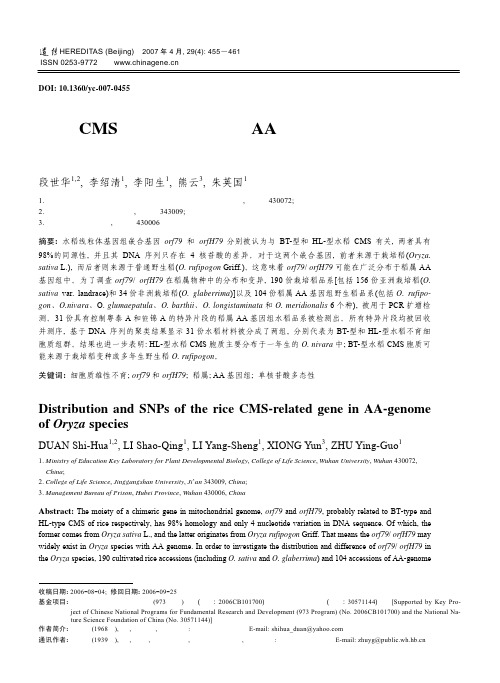
HEREDITAS (Beijing) 2007年4月, 29(4): 455―461 ISSN 0253-9772 研究报告收稿日期: 2006-08-04; 修回日期: 2006-09-25基金项目:国家重点基础研究发展规划(973计划)项目(编号: 2006CB101700)和自然科学基金项目(编号: 30571144)资助[Supported by Key Pro-ject of Chinese National Programs for Fundamental Research and Development (973 Program) (No. 2006CB101700) and the National Na-ture Science Foundation of China (No. 30571144)] 作者简介:段世华(1968—), 男, 博士生, 研究方向: 植物发育遗传学。
E-mail: shihua_duan@通讯作者: 朱英国(1939—), 男, 教授, 博士生导师, 中国工程院院士, 研究方向: 植物发育遗传学。
E-mail: zhuyg@DOI: 10.1360/yc-007-0455水稻CMS 相关基因在稻属AA 基因组中的分布及其单核苷酸多态性段世华1,2, 李绍清1, 李阳生1, 熊云3, 朱英国11. 武汉大学生命科学学院植物发育生物学教育部重点实验室, 武汉 430072;2. 井冈山大学生命科学学院, 吉安 343009;3. 湖北省监狱管理局, 武汉 430006摘要: 水稻线粒体基因组嵌合基因orf79 和 orfH79分别被认为与BT-型和HL-型水稻CMS 有关, 两者具有98%的同源性, 并且其DNA 序列只存在4核苷酸的差异。
对于这两个嵌合基因, 前者来源于栽培稻(Oryza. sativa L.), 而后者则来源于普通野生稻(O. rufipogon Griff.)。
云南疣粒野生稻细菌人工染色体(BAC)文库的构建与分析
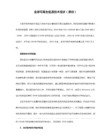
V ol.31,N o.6pp.815-817 Jun.,2005作 物 学 报ACT A AG RONOMICA SI NICA第31卷第6期2005年6月 815~817研究简报云南疣粒野生稻细菌人工染色体(BAC )文库的构建与分析阿新祥1 程在全2 吴成军2 鄢 波2 陈善娜1 杨明挚1 黄兴奇2,3Ξ(1云南大学生命科学学院,云南昆明650091;2云南省农科院生物技术研究所,云南昆明650223)Construction and Analysis of B acterial Artificial Chromosome (BAC)Library of Oryza granulata N ees et Arn 1ex W att 1in YunnanA X in 2X iang 1,CHE NG Z ai 2Quan 2,W U Cheng 2Jun 2,Y AN Bo 2,CHE N Shan 2Na 1,Y ANG M ing 2Zhi 1,H UANG X ing 2Qi 2,3(1College o f Life Sciences ,Yunnan Univer sity ,Kunming 650091,Yunnan ;2Biotechnology Research Institute ,Yunnan Academy o f Agricultural Sciences ,Kunming 650223,Yunnan ,China ) 我国有3种野生稻,即普通野生稻(Oryza rufipogon )、药用野生稻(O 1o fficinalis )、疣粒野生稻(O 1granulata )。
野生稻由于长期处于野生状态,经受了各种灾害和不良环境的自然选择,抗逆性较强,是天然的基因库,保持有栽培稻不具有或已经消失了的遗传基因,它在水稻育种中具有独特的作用,是水稻育种的宏厚物质基础。
但是,由于人为干扰破坏等种种原因,云南的野生稻和全国的野生稻一样也处于濒危状态[1]。
不同基因组野生稻随机微卫星扩增多态DNA(RMAPD)遗传分析
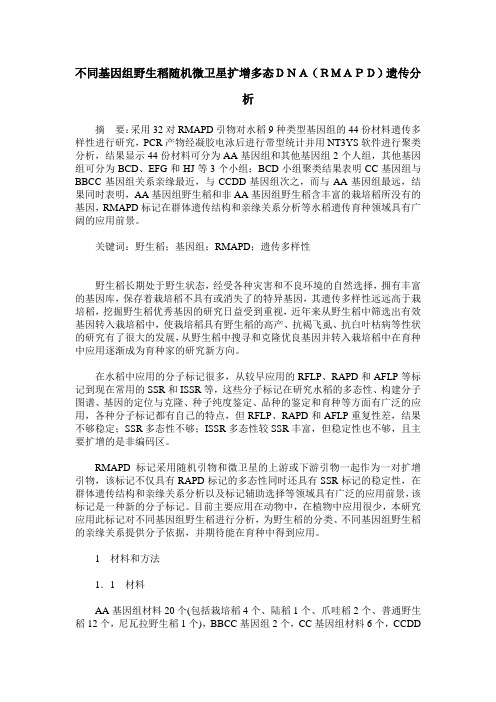
不同基因组野生稻随机微卫星扩增多态DNA(RMAPD)遗传分析摘要:采用32对RMAPD引物对水稻9种类型基因组的44份材料遗传多样性进行研究,PCR产物经凝胶电泳后进行带型统计并用NT3YS软件进行聚类分析,结果显示44份材料可分为AA基因组和其他基因组2个人组,其他基因组可分为BCD、EFG和HJ等3个小组;BCD小组聚类结果表明CC基因组与BBCC基因组关系亲缘最近,与CCDD基因组次之,而与AA基因组最远,结果同时表明,AA基因组野生稻和非AA基因组野生稻含丰富的栽培稻所没有的基因,RMAPD标记在群体遗传结构和亲缘关系分析等水稻遗传育种领域具有广阔的应用前景。
关键词:野生稻;基因组;RMAPD;遗传多样性野生稻长期处于野生状态,经受各种灾害和不良环境的自然选择,拥有丰富的基因库,保存着栽培稻不具有或消失了的特异基因,其遗传多样性远远高于栽培稻,挖掘野生稻优秀基因的研究日益受到重视,近年来从野生稻中筛选出有效基因转入栽培稻中,使栽培稻具有野生稻的高产、抗褐飞虱、抗白叶枯病等性状的研究有了很大的发展,从野生稻中搜寻和克隆优良基因并转入栽培稻中在育种中应用逐渐成为育种家的研究新方向。
在水稻中应用的分子标记很多,从较早应用的RFLP、RAPD和AFLP等标记到现在常用的SSR和ISSR等,这些分子标记在研究水稻的多态性、构建分子图谱、基因的定位与克隆、种子纯度鉴定、品种的鉴定和育种等方面有广泛的应用,各种分子标记都有自己的特点,但RFLP、RAPD和AFLP重复性差,结果不够稳定;SSR多态性不够;ISSR多态性较SSR丰富,但稳定性也不够,且主要扩增的是非编码区。
RMAPD标记采用随机引物和微卫星的上游或下游引物一起作为一对扩增引物,该标记不仅具有RAPD标记的多态性同时还具有SSR标记的稳定性,在群体遗传结构和亲缘关系分析以及标记辅助选择等领域具有广泛的应用前景,该标记是一种新的分子标记。
东乡野生稻叶绿体基因组拼接及系统进化分析
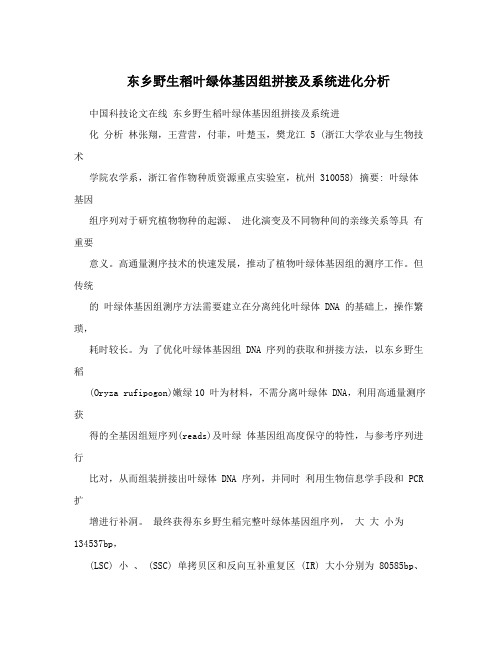
东乡野生稻叶绿体基因组拼接及系统进化分析中国科技论文在线东乡野生稻叶绿体基因组拼接及系统进化分析林张翔,王营营,付菲,叶楚玉,樊龙江 5 (浙江大学农业与生物技术学院农学系,浙江省作物种质资源重点实验室,杭州 310058) 摘要: 叶绿体基因组序列对于研究植物物种的起源、进化演变及不同物种间的亲缘关系等具有重要意义。
高通量测序技术的快速发展,推动了植物叶绿体基因组的测序工作。
但传统的叶绿体基因组测序方法需要建立在分离纯化叶绿体 DNA 的基础上,操作繁琐,耗时较长。
为了优化叶绿体基因组 DNA 序列的获取和拼接方法,以东乡野生稻(Oryza rufipogon)嫩绿10 叶为材料,不需分离叶绿体 DNA,利用高通量测序获得的全基因组短序列(reads)及叶绿体基因组高度保守的特性,与参考序列进行比对,从而组装拼接出叶绿体 DNA 序列,并同时利用生物信息学手段和 PCR 扩增进行补洞。
最终获得东乡野生稻完整叶绿体基因组序列,大大小为134537bp,(LSC) 小、 (SSC) 单拷贝区和反向互补重复区 (IR) 大小分别为 80585bp、12346bp 和 20803bp,共注释叶绿体基因 152 个。
基于获取的东乡野生稻及其他叶序列,通过构建进化树分析,结果显示在禾本绿体基因15 组科中水稻与麻竹 ( Dendrocalamus latiflorus)和黍亚科(Panicoideae)亲缘关系最近,粳稻与中国普通野生稻的亲缘关系较近,粳稻与籼稻并非同时驯化出现。
关键词:作物遗传学;东乡野生稻;叶绿体基因组;高通量测序;嫩绿叶中图分类号:S511.920 Assembly and phylogenetic analysis of Dongxiang wildrice chloroplast genome LIN Zhangxiang WANG Yingying FU Fei YE Chuyu FAN LongjiangDepartment of Agronomy College of Agriculture and Biotechnology Zhejiang Key Laboratory25 of Crop Germplasm Zhejiang University Hangzhou 310058 China Abstract: Complete chloroplast genome sequence is very useful for studying the evolution of species. The rapid development of high-throughput sequencing technology promotes the plant chloroplast genome sequencing. For traditional chloroplast genome sequencing method it is necessary to isolate and purify the chloroplast DNA before sequencing. Due to low concentration of chloroplast DNA it is30difficult to separate it from nuclear genome DNA. Therefore chloroplast DNA isolation-based method is tedious and time consuming. This study employed a simple and rapid method for chloroplast genome sequences acquisition without isolation of chloroplast DNA. Based on conservationof chloroplast genomes the whole genome short reads generated byIllumina Hiseq 2000 were directly used to map against chloroplast reference genomes. Subsequently the aligned reads were collected and further did35 de novo assembly. Finally the chloroplast genome sequence of Dongxiang wild rice was obtained. The chloroplast genome is 134537bp in size and has a typical quadripartite structure with the large LSC 80585bp and small copy SSC 12346bp regions separated by two copies of an inverted repeat IRs 20803bp each region. In total 152 chloroplast genes were successfully annotated. The phylogenetic tree of Dongxiang wildrice and 14 Poaceae chloroplast genomes shows that Dongxiang wild rice has a40 closer relationship with Dendrocalamus latiflorus and Panicoideae. Furthermore we build a phylogenetic tree based on SNPs of Dongxiang wild rice and other 22 Oryza chloroplast genomes. The result illustrates that indica has a closer relationship with wild rice-I while japonica are closer to wild rice-III suggesting that indica and japonica were domesticated during different periods Key words: crop genetics donxiang wild rice chloroplast genome high-throughput sequencing fresh45 green leaf 作者简介:林张翔1991-女硕士生物信息学通信联系人:樊龙江1965-男教授生物信息学. E-mail: -1- 中国科技论文在线 0 引言叶绿体是具有半自主遗传体系的细胞器,是绿色植物进行光合作用的重要场所。
云南疣粒野生稻部分cDNA片段的分离和注释
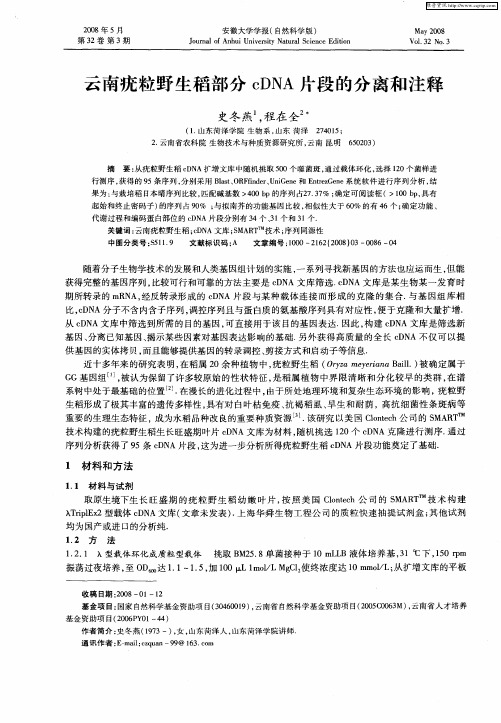
生稻形成了极其丰富的遗传多样性 , 具有对白叶枯免疫 、 抗褐稻虱、 早生和耐荫 , 高抗细菌性条斑病等 重要 的生 理生 态特征 , 为水稻 品种 改 良的重 要种 质资 源 _ . 研究 以美 国 Cot h公 司 的 S R 成 3该 J ln c e MA T
60 0 ) 5 23
摘
要: 从疣粒野生稻 e N D A扩增 中随机挑取 5 0个噬菌斑 , 0 通过载体环化 , 选择 10个 菌样进 2
行测序 , 获得的 9 5条序列 , 分别采用 BatO F n e、 nG n l 、 R f drU i ee和 E t z ee系统 软件进行序列 分析 , s i nr G n e 结 果为 : 与栽培稻 1本晴序列 比较 , 3 匹配碱基数 > 0 p的序列 占2 .7 ; 4 0b 7 3 % 确定可 阅读框(>10b , 0 p 具有 起始和终止密码子) 的序列 占9 % ; 0 与拟南芥的功能基因 比较 , 似性 大于 6 % 的有 4 相 0 6个 ; 确定功能 、 代谢过程和编码蛋 白部位的 e N D A片段分别有 3 4个 、1个和 3 3 1个列 同源性
M a 00 y2 8 Vo _ 2 No. l3 3
云南疣 粒野生稻部分 c N D A片段的分离和注释
史冬 燕 程 在 全 ,
(. 1 山东 菏 泽 学 院 生 物 系 , 山东 菏 泽 24 1 ; 70 5
2 云南 省农科 院 生物技术与种质资源研究所 , . 云南 昆明
供基 因 的实 体拷 贝 , 且能够 提供基 因的转 录调 控 、 接方 式 和启 动 子等信 息. 而 剪 近十 多年来 的研 究 表 明 , 在稻 属 2 种植 物 中 , 0余 疣粒 野 生稻 ( r am yr n a1) Oy eei aBi. 被确 定 属于 z a l
普通野生稻和亚洲栽培稻核心种质遗传多样性的检测研究
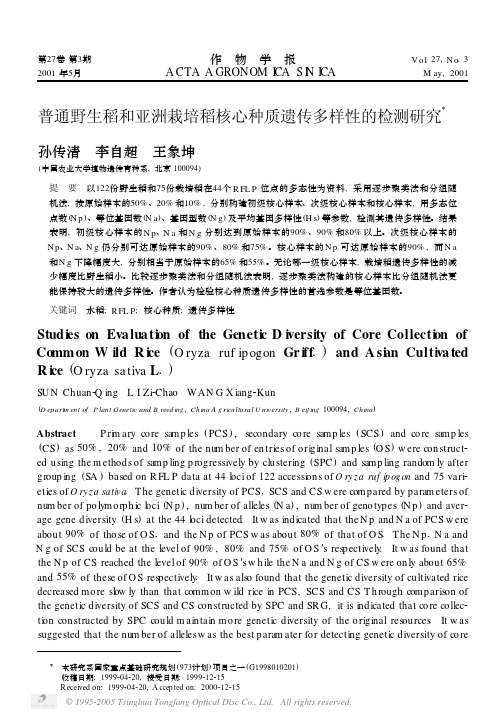
作 物 学 报 A CTA A GRONOM ICA S IN ICA
V o l. 27, N o. 3 M ay, 2001
普通野生稻和亚洲栽培稻核心种质遗传多样性的检测研究Ξ
孙传清 李自超 王象坤
(中国农业大学植物遗传育种系, 北京 100094)
提 要 以122份野生稻和75份栽培稻在44个 R FL P 位点的多态性为资料, 采用逐步聚类法和分组随 机法, 按原始样本的50%、20% 和10% , 分别构建初级核心样本、次级核心样本和核心样本, 用多态位 点数 (N p)、等位基因数 (N a)、基因型数 (N g) 及平均基因多样性 (H s) 等参数, 检测其遗传多样性。结果 表明, 初级核心样本的 N p、N a 和 N g 分别达到原始样本的90%、90% 和80% 以上。次级核心样本的 N p、N a、N g 仍分别可达原始样本的90%、80% 和75%。核心样本的 N p 可达原始样本的90% , 而 N a 和N g 下降幅度大, 分别相当于原始样本的65% 和55%。无论哪一级核心样本, 栽培稻遗传多样性的减 少幅度比野生稻小。比较逐步聚类法和分组随机法表明, 逐步聚类法构建的核心样本比分组随机法更 能保持较大的遗传多样性。作者认为检验核心种质遗传多样性的首选参数是等位基因数。
对单拷贝的探针而言, 每个探针检测了一个位点, 每一条多态性带可视为一个等位基 因, 每一种带型可视为一种基因型。用4个参数即多态位点数 (N p )、等位基因数 (N a)、基因 型数 (N g)、平均基因多样性 (H s) 评价原始样品和核心样品的遗传多样性[5]。
© 1995-2005 Tsinghua Tongfang Optical Disc Co., Ltd. All rights reserved.
五种野生稻叶绿体DNA多态性研究 Restriction Fragment Analysis of the Chloroplast DNA of 5 Wil
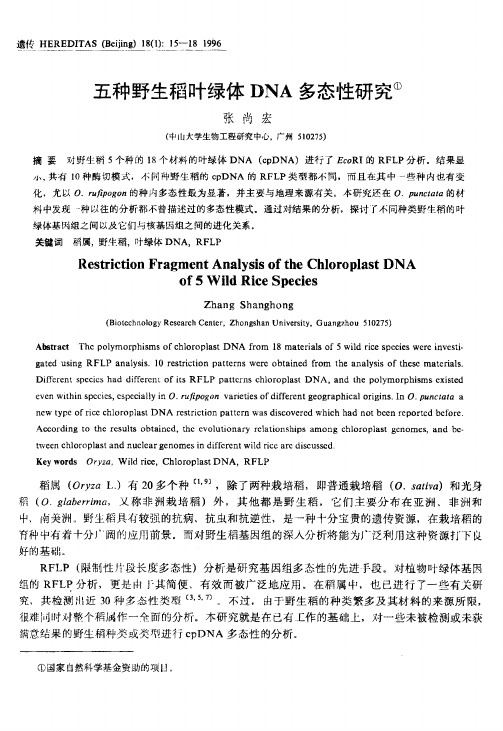
的结果,分别把它们命名为b c c, g i k, , l( 1 , 5 F , l k 1 , l , 2 , 2 和n 图 右和表 1。其中9 ) 种
酶切模式 (, e, , i, , n )已在以往对其他材料的分析中发现,而 k 这一模 b c 5 f g 2 k 1 l , ' , l , 1 2 式则是本研究新发现的。‘们均可显示 4 条左右的片段 ( 它 0 不包括分子量重复的片段数 日) , 。b c
}
’
D3 R8
W 53 9
I
’
马采 四业
Ei i lt .
印 度
{
,
b
c
}
}
W13 2 0
W 13 28
D1 S 4
新几内亚
新几 内亚
e 5
f l
f l
Olima . ti os n na t g a
O bvgl . iut rl a ei a O pna . ta uct
}
}
’
1L1 L1 6
Y 4 2 L4
T1 L 8
{
1
}
}
}
乍登
_} # 夕_ n
w麦 陇
神W ,
:
{
}
}
}
9
“
9
} “
Z1 B1 W1 7 5 7
W19 52
I I
w 二 tR G lH e 卿R
} }
i 2 k l
k l
k 2
!
I
_4 T P
}
_ _ 少. 甩
咯 麦 隆
}
k 1
W 19 50 W 02 1 4
中国大豆全长cDNA文库的结构与功能分析

( 天津现代职业技术学 院 ,天津 3 0 0 3 5 0 ) 摘要 :基 因组项 目包括侧 重于确定完整基 因组 序列 的结构基 因组学和侧重 于阐明基 因生物功 能的功能基 l 组学 。基 于大豆基 因组数据 ,研究大豆基 因在不 同发 育阶段和不 同环境条件下 的表 达情况 ,对 于大豆功能基因组学 具有 重要
me ho t d o f S MART .2 6 6 4 c DNA s e q u e n c e s a r e i d e n t i i f e d f r o m he t c DN A l i b r a r y, a n d t h e s t r u c t u r e a n d f u n c t i o n o f g e n e s a r e
S t r u c t u r e a n d F u n c t i o n An a l y s i s o f F u l l - l e n g t h c DNA L i b r a r y f r o m C h i n e s e S o y b e a n
C h i n e s e s o y b e a n s u i n o n g l 4 t o b u i l d a ul f l — l e n g t h c DNA l i b r a r y f r o m d fe i r e n t d e v e l o p me n t a n d e n v i r o n me n t b y a p p l y i n g he t
q u l a i t y f u l l — l e n g t h c D N A s e q u e n c e s ,w h i c h c o n ai t n t h e e n i t r e p r o t e i n c o d i n g r e i g o n s ,c a n p r o v i d e c o m p l e t e i n f o r ma t i o n t o类 号 :¥ 5 6 5 . 1 文 献 标 志 码 :A d o i :1 0 . 3 9 6 9 / j i s s n . 1 6 7 1 — 9 6 4 6 ( X) . 2 0 1 5 . 0 5 . 0 4 8
云南元江普通野生稻(Oryzarufipogon)群体籼粳分化的SSR
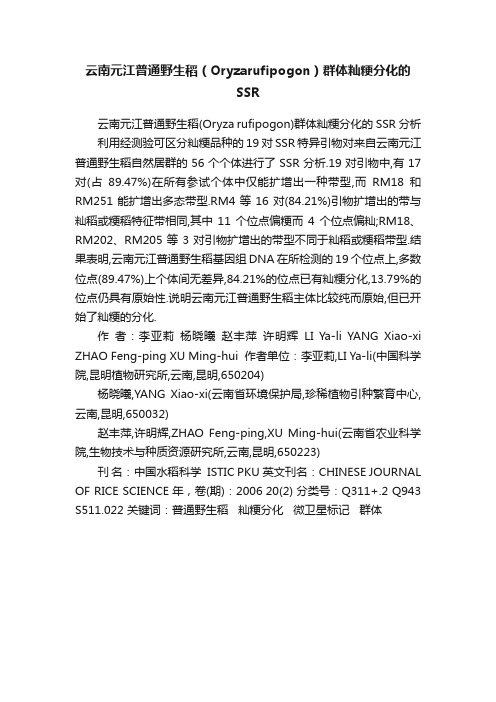
云南元江普通野生稻(Oryzarufipogon)群体籼粳分化的
SSR
云南元江普通野生稻(Oryza rufipogon)群体籼粳分化的SSR分析利用经测验可区分籼粳品种的19对SSR特异引物对来自云南元江普通野生稻自然居群的56个个体进行了SSR分析.19对引物中,有17对(占89.47%)在所有参试个体中仅能扩增出一种带型,而RM18和RM251能扩增出多态带型.RM4等16对(84.21%)引物扩增出的带与籼稻或粳稻特征带相同,其中11个位点偏粳而4个位点偏籼;RM18、RM202、RM205等3对引物扩增出的带型不同于籼稻或粳稻带型.结果表明,云南元江普通野生稻基因组DNA在所检测的19个位点上,多数位点(89.47%)上个体间无差异,84.21%的位点已有籼粳分化,13.79%的位点仍具有原始性.说明云南元江普通野生稻主体比较纯而原始,但已开始了籼粳的分化.
作者:李亚莉杨晓曦赵丰萍许明辉LI Ya-li YANG Xiao-xi ZHAO Feng-ping XU Ming-hui 作者单位:李亚莉,LI Ya-li(中国科学院,昆明植物研究所,云南,昆明,650204)
杨晓曦,YANG Xiao-xi(云南省环境保护局,珍稀植物引种繁育中心,云南,昆明,650032)
赵丰萍,许明辉,ZHAO Feng-ping,XU Ming-hui(云南省农业科学院,生物技术与种质资源研究所,云南,昆明,650223)
刊名:中国水稻科学 ISTIC PKU英文刊名:CHINESE JOURNAL OF RICE SCIENCE 年,卷(期):2006 20(2) 分类号:Q311+.2 Q943 S511.022 关键词:普通野生稻籼粳分化微卫星标记群体。
已完成基因组测序的生物(植物部分)分析解析
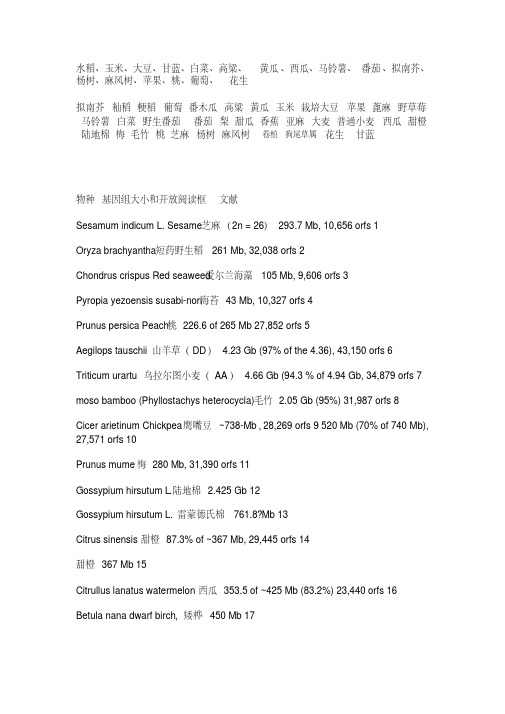
水稻、玉米、大豆、甘蓝、白菜、高粱、黄瓜、西瓜、马铃薯、番茄、拟南芥、杨树、麻风树、苹果、桃、葡萄、花生拟南芥籼稻粳稻葡萄番木瓜高粱黄瓜玉米栽培大豆苹果蓖麻野草莓马铃薯白菜野生番茄番茄梨甜瓜香蕉亚麻大麦普通小麦西瓜甜橙陆地棉梅毛竹桃芝麻杨树麻风树卷柏狗尾草属花生甘蓝物种基因组大小和开放阅读框文献Sesamum indicum L. Sesame 芝麻(2n = 26)293.7 Mb, 10,656 orfs 1Oryza brachyantha短药野生稻261 Mb, 32,038 orfs 2Chondrus crispus Red seaweed爱尔兰海藻105 Mb, 9,606 orfs 3Pyropia yezoensis susabi-nori海苔43 Mb, 10,327 orfs 4Prunus persica Peach 桃226.6 of 265 Mb 27,852 orfs 5Aegilops tauschii 山羊草(DD) 4.23 Gb (97% of the 4.36), 43,150 orfs 6Triticum urartu 乌拉尔图小麦(AA) 4.66 Gb (94.3 % of 4.94 Gb, 34,879 orfs 7moso bamboo (Phyllostachys heterocycla) 毛竹 2.05 Gb (95%) 31,987 orfs 8Cicer arietinum Chickpea鹰嘴豆~738-Mb,28,269 orfs 9 520 Mb (70% of 740 Mb), 27,571 orfs 10Prunus mume 梅280 Mb, 31,390 orfs 11Gossypium hirsutum L.陆地棉 2.425 Gb 12Gossypium hirsutum L. 雷蒙德氏棉761.8?Mb 13Citrus sinensis甜橙87.3% of ~367 Mb, 29,445 orfs 14甜橙367 Mb 15Citrullus lanatus watermelon 西瓜353.5 of ~425 Mb (83.2%) 23,440 orfs 16Betula nana dwarf birch,矮桦450 Mb 17Nannochloropsis oceanica CCMP1779微绿球藻(产油藻类之一)28.7 Mb,11,973 orfs 18Triticum aestivum bread wheat普通小麦17 Gb, 94,000 and 96,000 orfs 19Hordeum vulgare L. barley 大麦 1.13 Gb of 5.1 Gb,26,159 high confidence orfs,53,000 low confidence orfs 20Gossypium raimondii cotton 雷蒙德氏棉 D subgenome,88% of 880 Mb 40,976 orfs 21Linum usitatissimum flax 亚麻302 mb (81%), 43,384 orfs 22Musa acuminata banana 香蕉472.2 of 523?Mb, 36,542 orfs 23Cucumis melo L. melon 甜瓜375 Mb(83.3%)27,427 orfs 24Pyrus bretschneideri Rehd. cv. Dangshansuli 梨(砀山酥梨)512.0 Mb (97.1%), 42,812 orfs 25,26Solanum lycopersicum 番茄760/900 Mb,34727 orfs 27S. pimpinellifolium LA1589野生番茄739 MbSetaria 狗尾草属(谷子、青狗尾草)400 Mb,25000-29000 orfs 28,29Cajanus cajan pigeonpea木豆833 Mb,48,680 orfs 30Nannochloropis gaditana 一种海藻~29 Mb, 9,052 orfs 31Medicago truncatula蒺藜苜蓿350.2 Mb, 62,388 orfs 32Brassica rapa 白菜485 Mb 33Solanum tuberosum 马铃薯0.73 Mb,39031 orfs 34Thellungiella parvula条叶蓝芥13.08 Mb 29,338 orfs 35Arabidopsis lyrata lyrata 玉山筷子芥? 183.7 Mb, 32670 orfs 36Fragaria vesca 野草莓240 Mb,34,809 orfs 37Theobroma cacao 可可76% of 430 Mb, 28,798 orfs 38Aureococcus anophagefferens褐潮藻32 Mb, 11501 orfs 39Selaginella moellendorfii江南卷柏208.5 Mb, 34782 orfs 40Jatropha curcas Palawan麻疯树285.9 Mb, 40929 orfs 41Oryza glaberrima 光稃稻(非洲栽培稻)206.3 Mb (0.6x), 10 080 orfs (>70% coverage) 42Phoenix dactylifera 棕枣380 Mb of 658 Mb, 25,059 orfs 43Chlorella sp. NC64A小球藻属40000 Kb, 9791 orfs 44Ricinus communis蓖麻325 Mb, 31,237 orfs 45Malus domestica (Malus x domestica)苹果742.3 Mb 46Volvox carteri f. nagariensis 69-1b一种团藻120 Mb, 14437 orfs 47Brachypodium distachyon 短柄草272?Mb,25,532 orfs 48Glycine max cultivar Williams 82栽培大豆 1.1 Gb, 46430 orfs 49Zea mays ssp. Mays Zea mays ssp. Parviglumis Zea mays ssp. Mexicana Tripsacum dactyloides var. meridionale 无法下载附表50Zea mays mays cv. B73玉米 2.06 Gb, 106046 orfs 51Cucumis sativus 9930 黄瓜243.5 Mb, 63312 orfs 52Micromonas pusilla金藻21.7 Mb, 10248 orfs 53Sorghum bicolor 高粱697.6 Mb, 32886 orfs 54Phaeodactylum tricornutum 三角褐指藻24.6 Mb, 9479 orfs 55Carica papaya L. papaya 番木瓜271 Mb (75%), 28,629 orfs 56Physcomitrella patens patens小立碗藓454 Mb, 35805 orfs 57Vitis vinifera L. Pinot Noir, clone ENTAV 115葡萄504.6 Mb, 29585 orfs 58Vitis vinifera PN40024葡萄475 Mb 59Ostreococcus lucimarinus绿色鞭毛藻13.2 Mb, 7640 orfs 60Chlamydomonas reinhardtii 莱茵衣藻100 Mb, 15256 orfs 61Populus trichocarpa黑三角叶杨550 Mb, 45000 orfs 62Ostreococcus tauri 绿藻12.6 Mb, 7892 orfs 63Oryza sativa ssp. japonica 粳稻360.8 Mb, 37544 orfs 64Thalassiosira pseudonana 硅藻25 Mb, 11242 orfs 65Cyanidioschyzon merolae 10D红藻16.5 Mb, 5331 orfs 66Oryza sativa ssp. japonica粳稻420 Mb, 50000 orfs 67Oryza sativa L. ssp. Indica籼稻420 Mb, 59855 orfs 68Guillardia theta -蓝隐藻,551 Kb, 553 orfs 69Arabidopsis thaliana Columbia拟南芥119.7 Mb, 31392 orfs 70参考文献1 Zhang, H. et al. Genome sequencing of the important oilseed crop Sesamum indicum L. Genome Biology 14, 401 (2013).2 Chen, J. et al. Whole-genome sequencing of Oryza brachyantha reveals mechanisms underlying Oryza genome evolution. Nat Commun 4, 1595 (2013).n, J. et al. Genome structure and metabolic features in the red seaweed3 ColléChondrus crispus shed light on evolution of the Archaeplastida. Proceedings of the National Academy of Sciences 110, 5247-5252 (2013).4 Nakamura, Y. et al. The first symbiont-free genome sequence of marine red alga, susabi-nori Pyropia yezoensis. PLoS ONE 8, e57122 (2013).5 Verde, I. et al. The high-quality draft genome of peach (Prunus persica) identifies unique patterns of genetic diversity, domestication and genome evolution. Nature Genetics advance online publication (2013).6 Jia, J. et al. Aegilops tauschii draft genome sequence reveals a gene repertoire for wheat adaptation. Nature 496, 91-95 (2013).7 Ling, H.-Q. et al. Draft genome of the wheat A-genome progenitor Triticum urartu. Nature 496, 87-90 (2013).8 Peng, Z. et al. The draft genome of the fast-growing non-timber forest species moso bamboo (Phyllostachys heterocycla). Nature Genetics 45, 456-461 (2013).9 Jain, M. et al. A draft genome sequence of the pulse crop chickpea (Cicer arietinum L.). Plant Journal, DOI: 10.1111/tpj.12173 (2013).10 Varshney, R. K. et al. Draft genome sequence of chickpea (Cicer arietinum) provides a resource for trait improvement. Nat Biotech 31, 240-246 (2013).11 Zhang, Q. et al. The genome of Prunus mume. Nat Commun 3, 1318 (2012).12 Lee, M.-K. et al. Construction of a plant-transformation-competent BIBAC library and genome sequence analysis of polyploid Upland cotton (Gossypium hirsutum L.). BMC Genomics 14, 208 (2013).13 Paterson, A. H. et al. Repeated polyploidization of Gossypium genomes and the evolution of spinnable cotton fibres. Nature 492, 423-427 (2012).14 Xu, Q. et al. The draft genome of sweet orange (Citrus sinensis). Nat Genet 45,59–66 (2013).15 Belknap, W. R. et al. Characterizing the citrus cultivar Carrizo genome through454 shotgun sequencing. Genome 54, 1005-1015 (2011).16 Guo, S. et al. The draft genome of watermelon (Citrullus lanatus) and resequencing of 20 diverse accessions. Nat Genet 45, 51–58 (2013).17 Wang, N. et al. Genome sequence of dwarf birch (Betula nana) and cross-species RAD markers. Mol Ecol Article first published online: 21 NOV 2012 DOI:10.1111/mec.12131 (2012).18 Vieler, A. et al. Genome, functional gene annotation, and nuclear transformation of the heterokont oleaginous alga Nannochloropsis oceanica CCMP1779. PLoS Genet 8, e1003064 (2012).19 Brenchley, R. et al. Analysis of the bread wheat genome using whole-genome shotgun sequencing. Nature 491, 705-710 (2012).20 Consortium, T. I. B. G. S. A physical, genetic and functional sequence assembly of the barley genome. Nature 491, 711–716 (2012).21 Wang, K. et al. The draft genome of a diploid cotton Gossypium raimondii. Nature Genetics 44, 1098–1103 (2012).22 Wang, Z. et al. The genome of flax (Linum usitatissimum) assembled de novofrom short shotgun sequence reads. The Plant Journal 72, 461-473 (2012).23 D'Hont, A. et al. The banana (Musa acuminata) genome and the evolution of monocotyledonous plants. Nature 488, 213–217 (2012).24 Garcia-Mas, J. et al. The genome of melon (Cucumis melo L.). PNAS 109,11872-11877 (2012).25 reporter, A. G. s. Consortium releases pear genome data. GenomeWeb Daily News (2012).26 Wu, J. et al. The genome of pear (Pyrus bretschneideri Rehd.). GenomeRes.Published in Advance November 13, 2012, doi:10.1101/gr.144311.112 (2012).27 Consortium, T. T. G. The tomato genome sequence provides insights into fleshy fruit evolution. Nature 485, 635–641 (2012).28 Bennetzen, J. L. et al. Reference genome sequence of the model plant Setaria. Nat Biotech 30, 555-561 (2012).29 Zhang, G. et al. Genome sequence of foxtail millet (Setaria italica) provides insights into grass evolution and biofuel potential. Nat Biotech 30, 549-554 (2012).30 Varshney, R. K. et al. Draft genome sequence of pigeonpea (Cajanus cajan), an orphan legume crop of resource-poor farmers. Nat Biotech 30, 83-89 (2012).31 Radakovits, R. et al. Draft genome sequence and genetic transformation of the oleaginous alga Nannochloropis gaditana. Nat Commun 3, 686 (2012).32 Young, N. D. et al. The Medicago genome provides insight into the evolution of rhizobial symbioses. Nature 480, 520–524 (2011).33 Wang, X. et al. The genome of the mesopolyploid crop species Brassica rapa. Nat. Genet. 43, 1035-1039 (2011).34 Consortium, T. P. G. S. Genome sequence and analysis of the tuber crop potato. Nature 475, 189-195 (2011).35 Dassanayake, M. et al. The genome of the extremophile crucifer Thellungiella parvula. Nat. Genet. 43, 913-918 (2011).36 Hu, T. T. et al. The Arabidopsis lyrata genome sequence and the basis of rapid genome size change. Nat. Genet. 43, 476-481 (2011).37 Shulaev, V. et al. The genome of woodland strawberry (Fragaria vesca). Nat. Genet. 43, 109-116 (2011).38 Argout, X. et al. The genome of Theobroma cacao. Nat. Genet. 43, 101-108 (2011).39 Gobler, C. J. et al. Niche of harmful alga Aureococcus anophagefferens revealed through ecogenomics. PNAS 108, 4352-4357 (2011).40 Banks, J. A. et al. The selaginella genome identifies genetic changes associated with the evolution of vascular plants. Science 332, 960-963 (2011).41 Sato, S. et al. Sequence analysis of the genome of an oil-bearing tree, Jatropha curcas L. DNA Res. 18, 65-76 (2011).42 Sakai, H. et al. Distinct evolutionary patterns of Oryza glaberrima deciphered by genome sequencing and comparative analysis. Plant Journal 66, 796-805 (2011).43 Al-Dous, E. K. et al. De novo genome sequencing and comparative genomics of date palm (Phoenix dactylifera). Nat Biotech 29, 521-527 (2011).44 Blanc, G. et al. The Chlorella variabilis NC64A genome reveals adaptation to photosymbiosis, coevolution with viruses, and cryptic sex. Plant Cell 22, 2943-2955 (2010).45 Chan, A. P. et al. Draft genome sequence of the oilseed species Ricinus communis. Nat Biotech 28(951-956 (2010).46 Velasco, R. et al. The genome of the domesticated apple (Malus x domestica Borkh.). Nat. Genet. 42, 833-839 (2010).47 Prochnik, S. E. et al. Genomic analysis of organismal complexity in the multicellular green alga Volvox carteri. Science 329, 223-226 (2010).48 Initiative, T. I. B. Genome sequencing and analysis of the model grass Brachypodium distachyon. Nature 463, 763-768 (2010).49 Schmutz, J. et al. Genome sequence of the palaeopolyploid soybean. Nature 463, 178-183 (2010).50 Hufford, M. B. et al. Comparative population genomics of maize domesticationand improvement. Nat Genet 44, 808-811 (2012).51 Wei, F. et al. The physical and genetic framework of the maize B73 genome. PLoS Genet 5, e1000715 (2009).52 Huang, S. et al. The genome of the cucumber, Cucumis sativus L. Nat. Genet. 41, 1275-1281 (2009).53 Worden, A. Z. et al. Green evolution and dynamic adaptations revealed by genomes of the marine picoeukaryotes Micromonas. Science 324, 268-272 (2009).54 Paterson, A. H. et al. The Sorghum bicolor genome and the diversification of grasses. Nature 457, 551-556 (2009).55 Bowler, C. et al. The Phaeodactylum genome reveals the evolutionary history of diatom genomes. Nature 456, 239-244 (2008).56 Ming, R. et al. The draft genome of the transgenic tropical fruit tree papaya (Carica papaya Linnaeus). Nature 452, 991-996 (2008).57 Rensing, S. A. et al. The Physcomitrella genome reveals evolutionary insights into the conquest of land by plants. Science 319, 64-69 (2008).58 Velasco, R. et al. A high quality draft consensus sequence of the genome of a heterozygous grapevine variety. PLoS One 2, e1326 (2007).59 Jaillon, O. et al. The grapevine genome sequence suggests ancestral hexaploidization in major angiosperm phyla. Nature 449, 463-467 (2007).60 Palenik, B. et al. The tiny eukaryote Ostreococcus provides genomic insights into the paradox of plankton speciation. PNAS 104, 7705-7710 (2007).61 Merchant, S. S. et al. The Chlamydomonas genome reveals the evolution of key animal and plant functions. Science 318, 245-250 (2007).62 Tuskan, G. A. et al. The genome of black cottonwood, Populus trichocarpa (Torr. & Gray). Science 313, 1596-1604 (2006).63 Derelle, E. et al. Genome analysis of the smallest free-living eukaryote Ostreococcus tauri unveils many unique features. PNAS 103, 11647-11652 (2006).64 Project, I. R. G. S. The map-based sequence of the rice genome. Nature 436,793-800 (2005).65 Armbrust, E. V. et al. The genome of the diatom Thalassiosira Pseudonana: ecology, evolution, and metabolism. Science 306, 79-86 (2004).66 Matsuzaki, M. et al. Genome sequence of the ultrasmall unicellular red alga Cyanidioschyzon merolae 10D. Nature 428, 653-657 (2004).67 Goff, S. A. et al. A draft sequence of the rice genome (Oryza sativa L. ssp. japonica). Science 296, 92-100 (2002).68 Yu, J. et al. A draft sequence of the rice genome (Oryza sativa L. ssp. indica). Science 296, 79-92 (2002).69 Douglas, S. et al. The highly reduced genome of an enslaved algal nucleus. Nature 410, 1091-1096 (2001).70 Kaul, S. et al. Analysis of the genome sequence of the flowering plant Arabidopsis thaliana. Nature 408, 796-815 (2000).。
- 1、下载文档前请自行甄别文档内容的完整性,平台不提供额外的编辑、内容补充、找答案等附加服务。
- 2、"仅部分预览"的文档,不可在线预览部分如存在完整性等问题,可反馈申请退款(可完整预览的文档不适用该条件!)。
- 3、如文档侵犯您的权益,请联系客服反馈,我们会尽快为您处理(人工客服工作时间:9:00-18:30)。
carboxylase
-
BE429292.1
-
(Triticum turgidum)
-
FF534517.1
-
(Manihot esculenta)
-
EH277383.1
-
(Spartina
alterniflora)
二、水稻新基因
• 定义:能定位到栽培稻基因组序列的同源,但无任何已知水稻表达序列的同源。 与rice MPSS搜索比较几乎没有找到匹配片段。
99
CU861795 475
99
CU406355 837
100
CU406396 520
Chr location 05 09
12
02
Identity(%) Antisense protein
99
CA764081 DNA-directed RNA polymerase 3
79
CT858901 -
97
AK107125 AP2 domain, putative
1888 W1943 cDNAs BLAST against cultivated rice genomic sequences and cDNAs
1888 W1943 cDNAs SSR comparison with indica and japonica cDNAs
一、未匹配粳稻基因组之基因
CU8616CT841937 1552
08
98
AK106713 -
注:该17个基因均没有找到任何蛋白同源匹配。右侧的7个基因与已知的 水稻表达序列成反义RNA对。
三、W1943特有剪切方式基因
• 定义:与栽培稻japonica基因组序列完全一致(100% identity),同时与栽培稻表达序列同 源但剪切方式独有(独特的AS剪切方式)。
-
CU406778
CU406596 Contig001277 AK242711
-
CU861677
CT842008 Contig008507 CT856206
--
CT841912
93-11 contigs
Contig003011 Contig000750 -
ESTs or mRNA hits CT859459 AK099287 CT856885
• 解释:水稻新基因。或者在栽培稻中表达量过低难于克隆,或者野生稻特有。
name
Len(bp)
CU406910 656 CU406138 568 CU406022 543 CU405757 477
Chr location 10 02
12
04
Identity(%) name
Len(bp)
99
CU405785 727
野生稻O. rufipogon W1943 1888 条全长cDNA序列的数据分析
NCGR 2008-09-03
背景
• 野生稻O. rufipogon(AA genome)是与栽培 稻关系最近的祖先水稻品种1,2。
• 具有许多优于栽培稻的农艺性状,比如耐旱、耐 盐等等3,4;
• 公共数据库中有大量栽培稻的基因组序列信息5,6, 同时也有大量的cDNA资源7,8;
99
AK103485 -
CU406921 414
02
100
CU406535 389
02
100
CU406832 530
10
92
CU406871 458
01
84
CU861804 383
06
99
CU861721 554
01
100
CT841800 941
11
99
AK121962 patatin, putative
name
93-11 contigs
CT842002 CT842007 CU405940
Contig005912 Contig008507 Contig001402
ESTs or mRNA hits AK241925 CT856206 AK103326
protein
-
name
CU406895 CU861744 CU405657
• 极少野生稻的序列和克隆资源,比较成规模的是 Oryza minuta (BBCC genome) 5,211条叶片 ests9。
现状与目的
• NCGR野生稻资源:克隆并精确测序了1,888个 unique的O. rufipogon W1943 cDNA克隆。
• 期望通过W1943 cDNA序列与籼、粳稻cDNA序 列的比较: 汇总一些水稻新基因、潜在野生稻特有的基因、 W1943特有剪切方式基因、组织特异性高表达的 基因和与microRNA相关的基因; 提供一些线索,供有兴趣者作进一步研究之用。
CU406172 Contig014596 CT842006 Contig000383
AK242967 AK111647
CU861753 Contig000750 AK099287
CU406308 Contig000444 CT841996 Contig002576 CU406568 Contig003848
• 解释:或只是尚未克隆到该AS表达方式;或为野生稻所独具。
name CT841942 CU406810 CT841893 CT841874 CU405853 CU405923 CU406279 CU406025 CT841561 CU406579 CU406935 CU406600 CU405570 CU406091 CU406134
• 定义:未能定位到O. sativa japonica Nipponbare genome sequences,但与籼稻93-11基因组序 列有同源或与水稻ests序列有同源或与其它禾本科ests序列有同源。 且去除与细菌有同源的基因
• 解释:或者落于粳稻基因组测序gap中,或者籼稻特有的基因,或者野生稻特有基因。
protein
ring-box protein -
-
CA766528
-
-
CT836656
60S ribosomal
protein L7A
-
CA756235
60S ribosomal
protein L17
-
NM_001063334
-
-
AC145809
-
-
CN130755.1
ribulose-
(Sorghum bicolor) bisphosphate
AK070131 CT834800 AK064050
-
CT841712
GTP-binding protein
ring-box protein
-
-
Bowman Birk trypsin inhibitor
CU405768
CU405675
CU406202 CU406924 CU405898
CU406582 Contig000444 AK107776
